|
Use [CONTR + F] to search this page and pull down this scroll bar to see everything.
|
Survey of Dutch stamps about foreign railways |
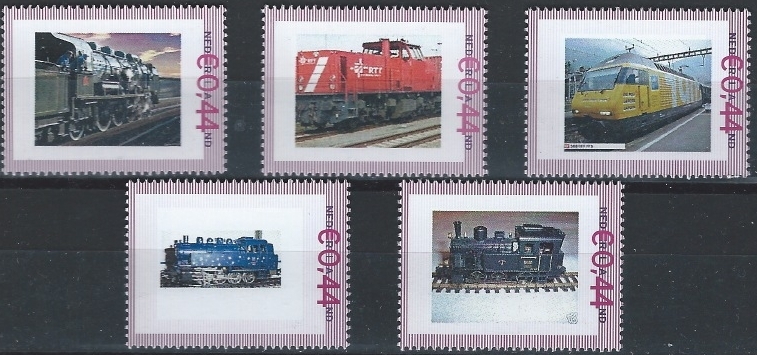 |
2007: Set of five personalized stamps, one with the French SNCF 231 G538 Sotteville, then an RTT loco and the third is a Swiss SBB Re 460 La Poste mail train. Below these three there are two model steam locos. No entry in official catalogue |
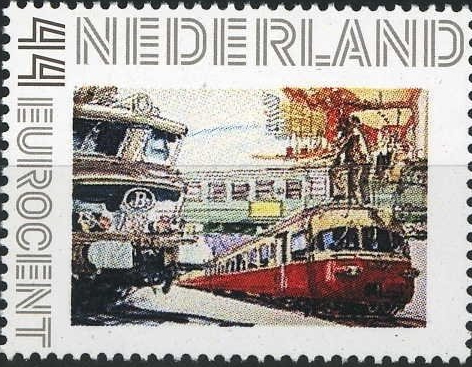 |
2007: Artist's impression of a Belgian diesel locomotive and a TEE train. No entry in official catalogue |
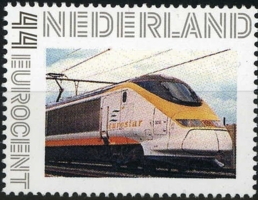
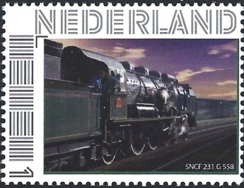 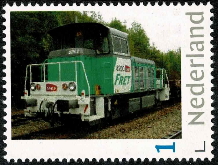
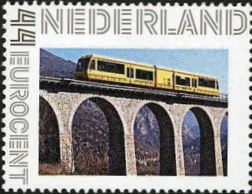 |
2008: Four personalized stamps with the French trains, respectively Eurostar, SNCF 231 G538 Sotteville, SNCF FRET 8200 and Le Train Jaune (the yellow train). No entry in official catalogue |
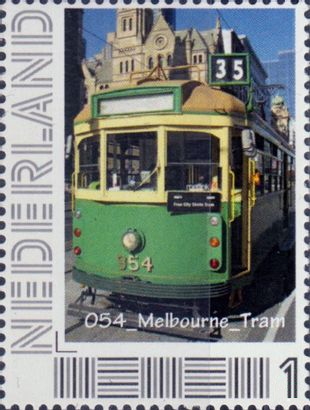
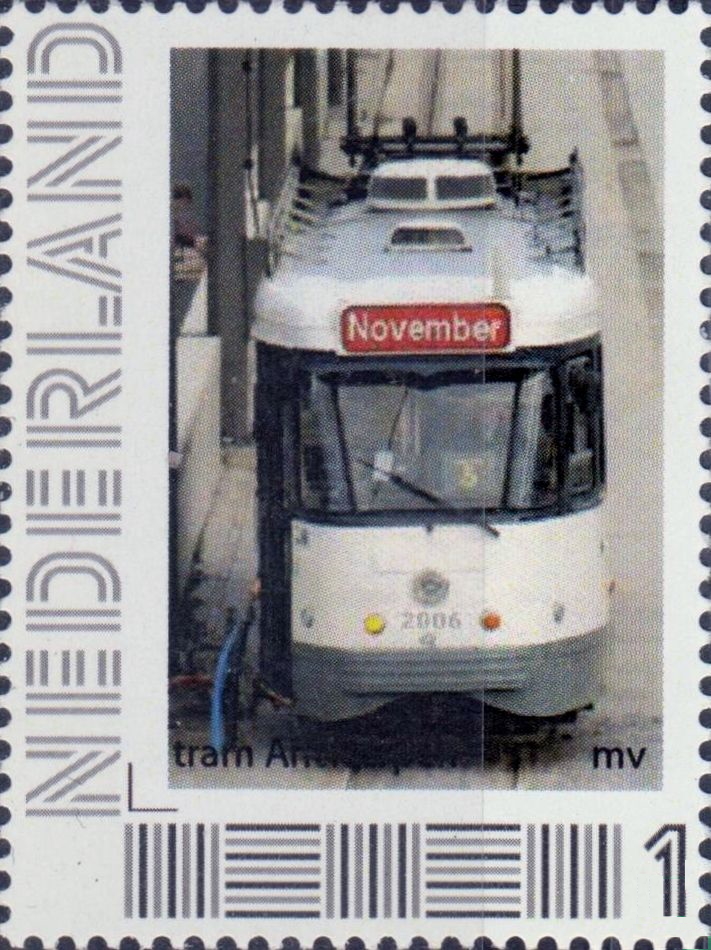
 
 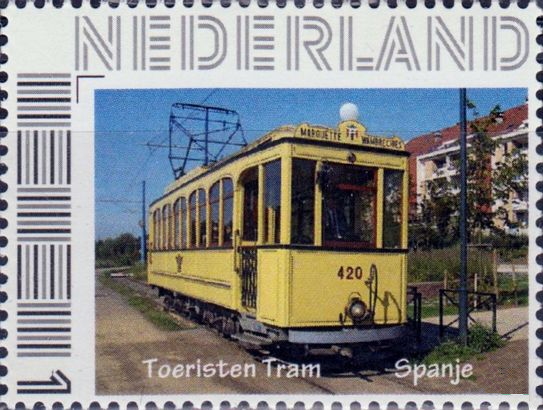
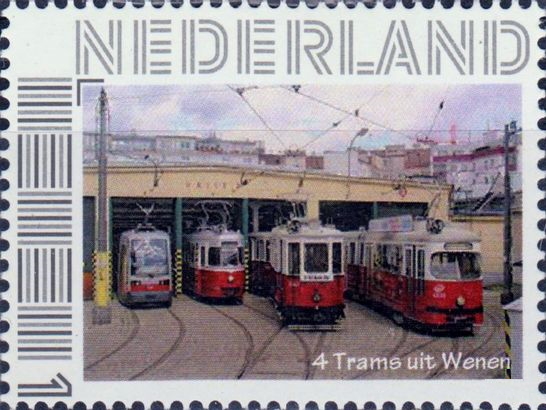 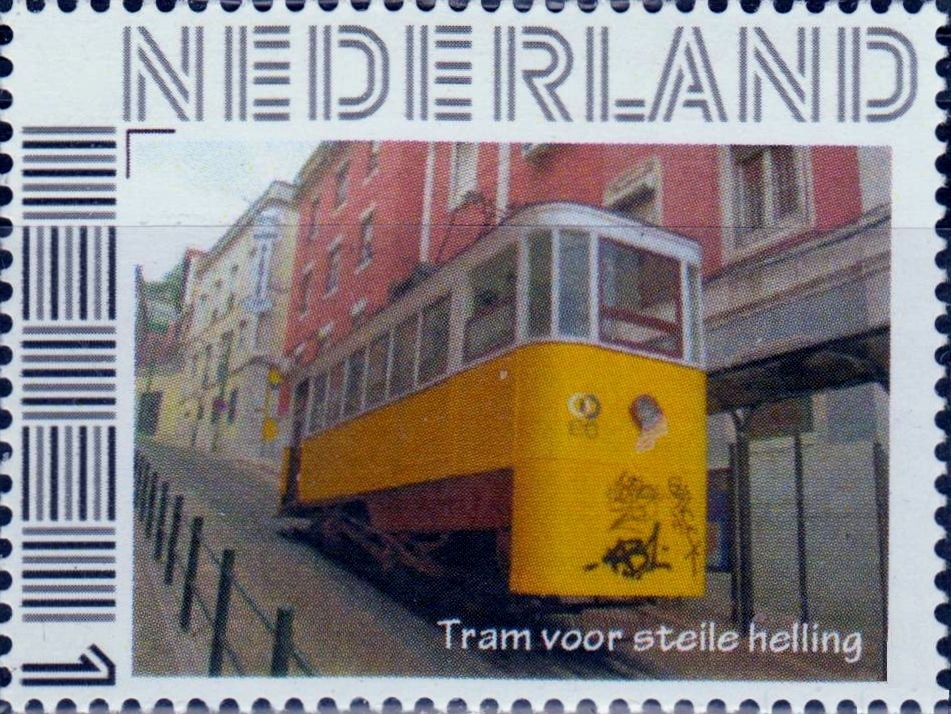
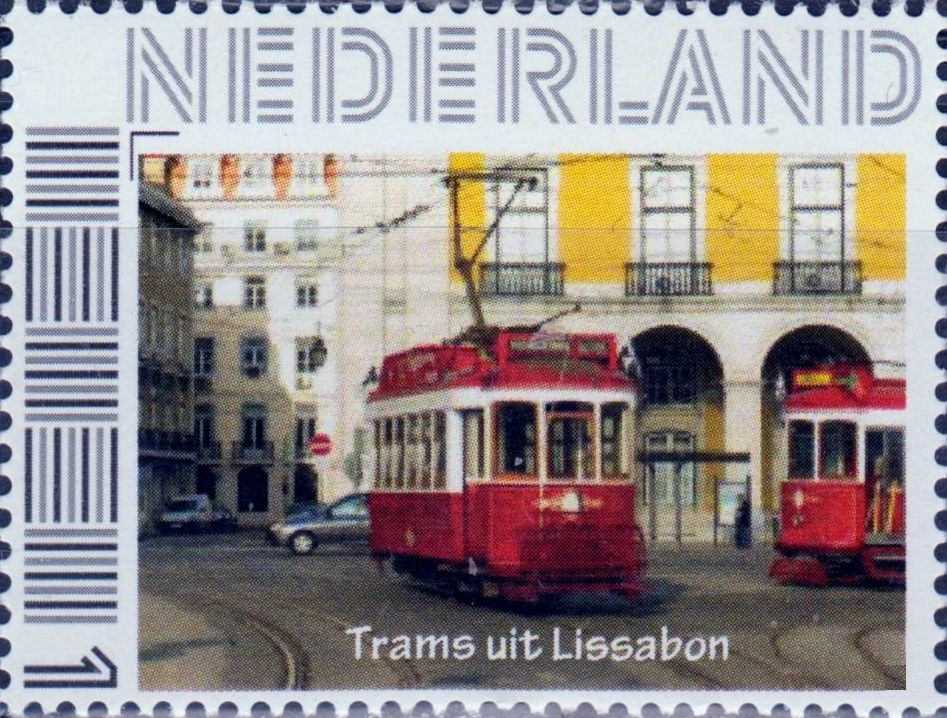 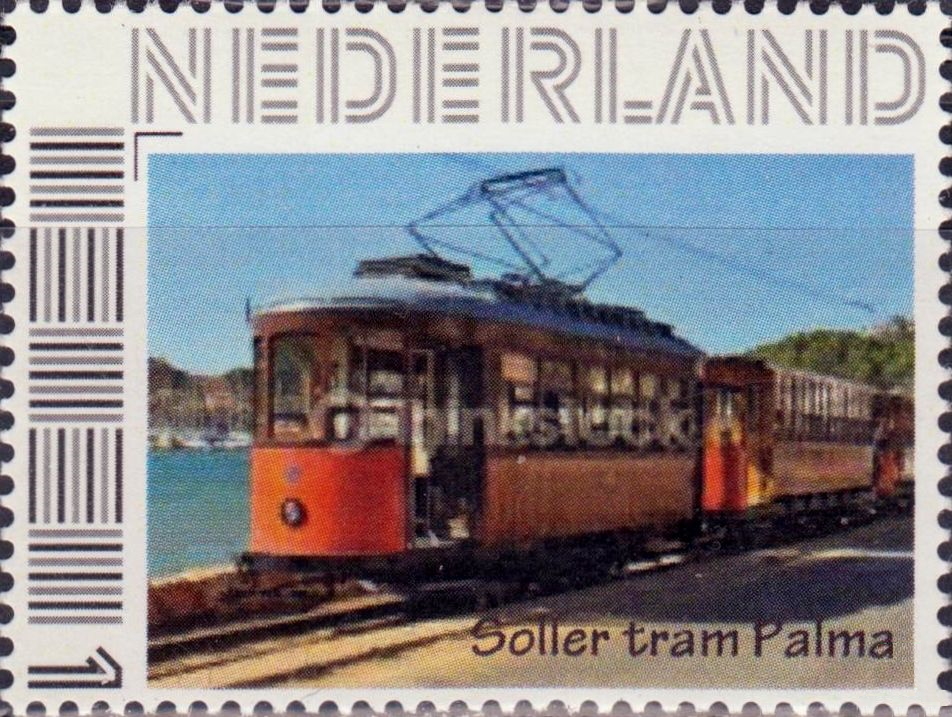
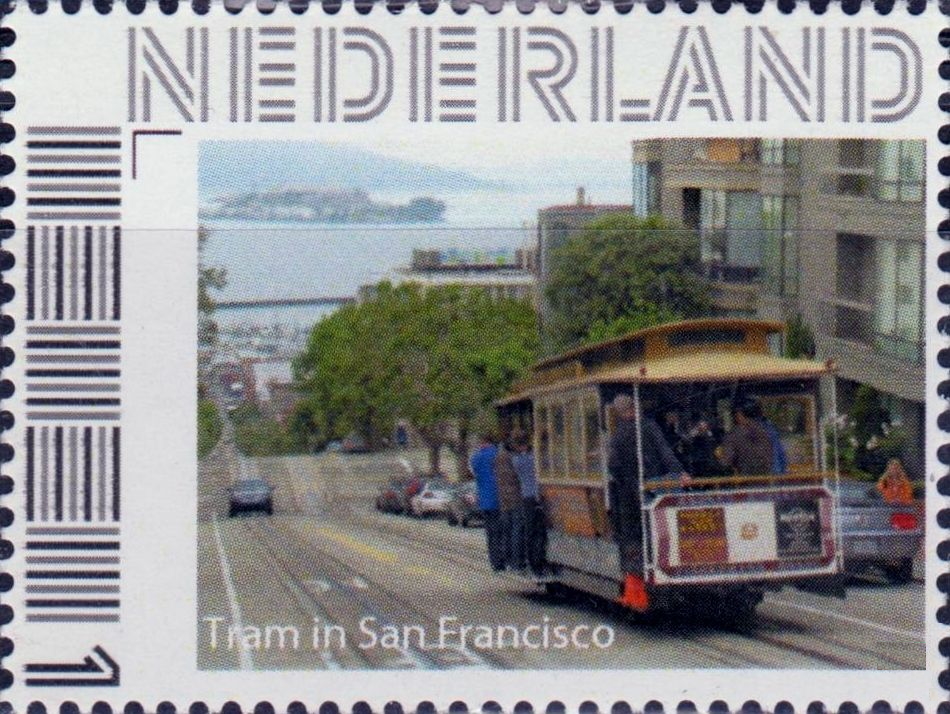 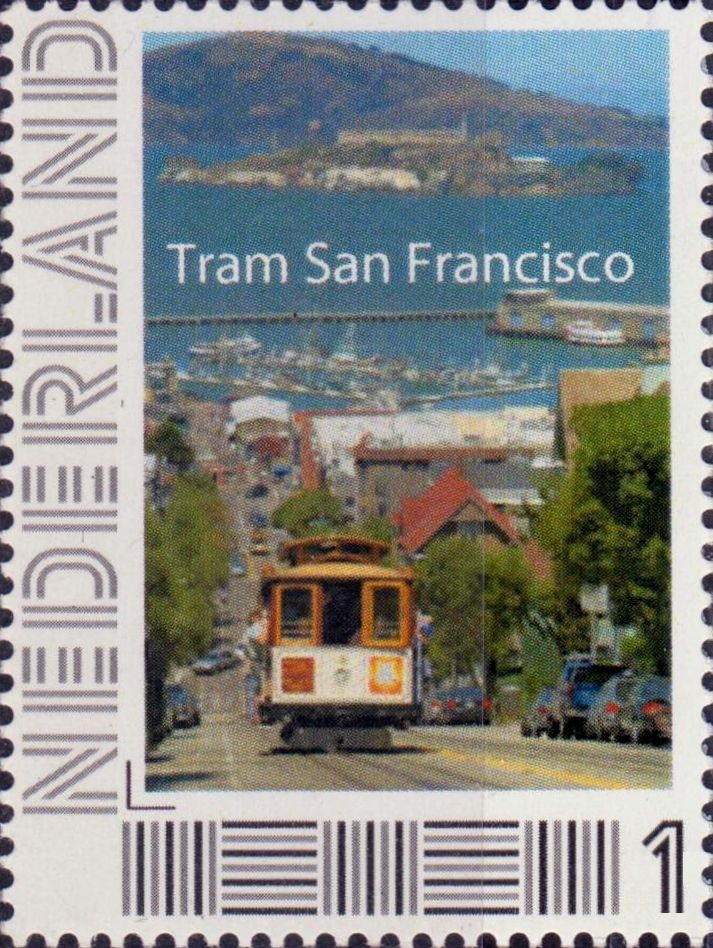
|
year unknown: Several foreign trams, respectively from: Melbourne, Australia; Antwerpen, Belgium (2x); Blackpool, England; Spain, tourist train; Vienna, Austria; Lissabon, Portugal (2x); Palma de Mallorca, Spain; San Francisco, USA (2x). No entry in official catalogue |
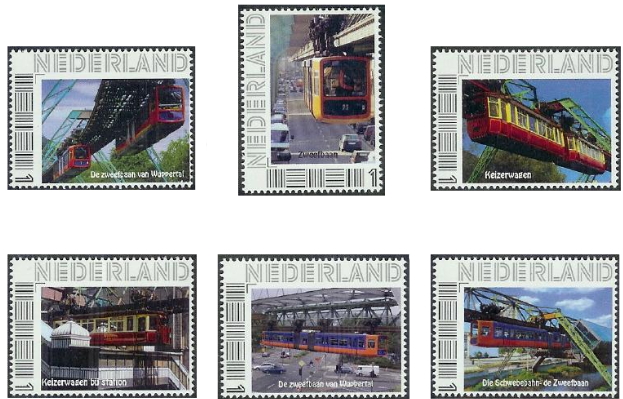 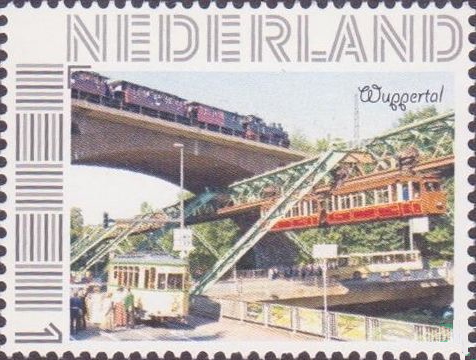
|
year unknown: Set of six personalized stamps with the Wuppertal suspension railway plus one odd-man-out which also shows the Wuppertal suspension railway. No entry in official catalogue |
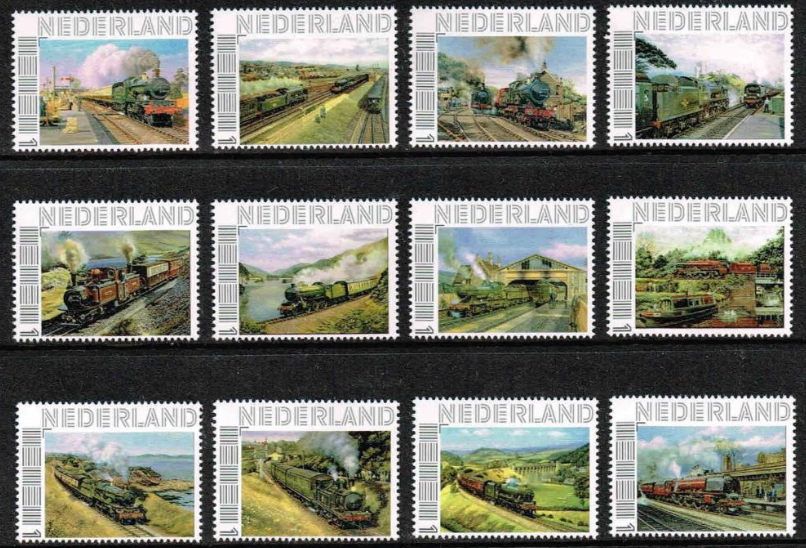 |
year unknown: Set of twelve personalized stamps with rail scenes and locomotives in Great Britain No entry in official catalogue |
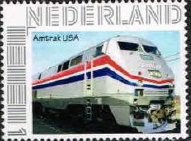

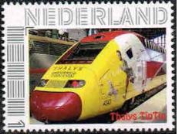 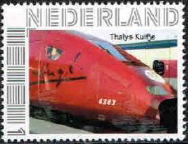
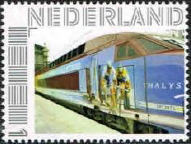
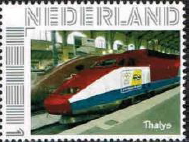 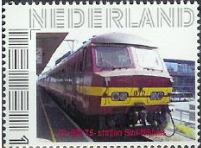
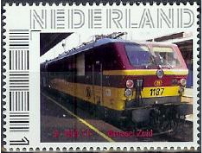
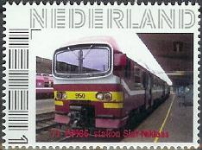 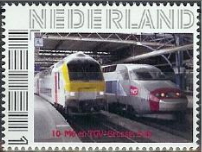
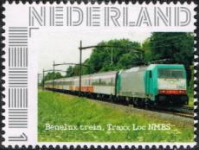

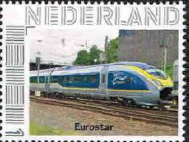
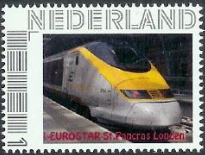
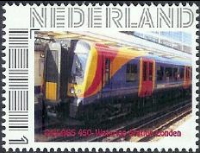 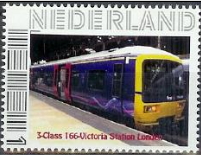
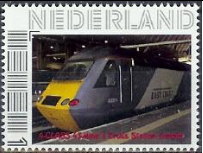
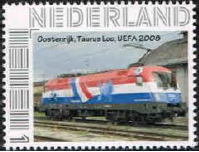 

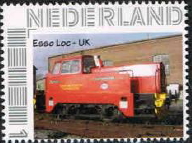 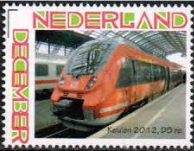
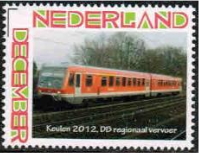
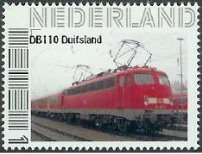 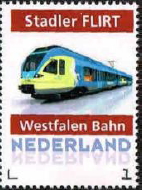

 
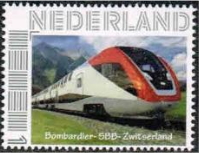
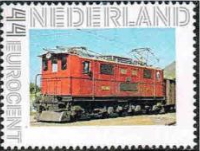 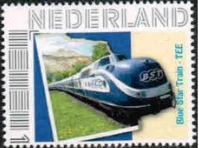
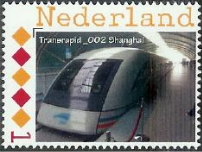
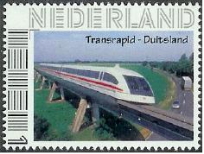 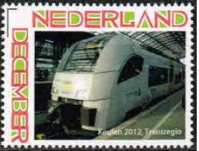
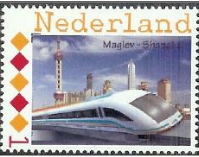
 |
years unknown: (from 2010-2017) Some personalized stamps with several foreign locomotives: An American Amtrak and then some Belgian Thalys trains. The first with captain Haddock alongside. The second with Tin Tin on it. Three more Belgian Thalys trains. Three Belgian locomotives at Brussels: numbers 075, 1187, 950. Two stamps with Eurostar (Paris- London) and a UK HST. Then two other British trainstamps and an Austrian Taurus in UEFA 2008 championship livery. Two locos at Brussels South Station, a Belgian TAXX loco and an InfraBel loco. An Italian Arena Ways and then two ESSO locos, one from Canada and the other from the UK Three German trains: a local train in Cologne, a regional train in Cologne and a DB 110. A German Stadler FLIRT of the Westfalen Railway. FLIRT stood origially for: Flinker Leichter Innovativer Regionaltriebzug, and in English: Fast Light Innovative Regional Train. Later it became Flinker Leichter Intercity- und Regional-Triebzug ,in English: Fast Light Intercity- and Regional Train. An then a Deutsche Bahn eloco. And from France a TGV From Switzerland: Allegra from the Rhätische Bahn, an SBB Bonbardier and a Swiss eloco. A Blue Star TEE, a Chinese transrapid at Shanghai and a German maglev transrapid. A German transregional train at Cologne, a Japanese maglev and a foreign monorail. No entry in official catalogue |

 
 

|
years unknown: Personalized priority stamps for Europe in pairs with foreign trains. Two German steam locos, two TGVs, an American Union Pacific diesel, an ICE3. No entry in official catalogue |

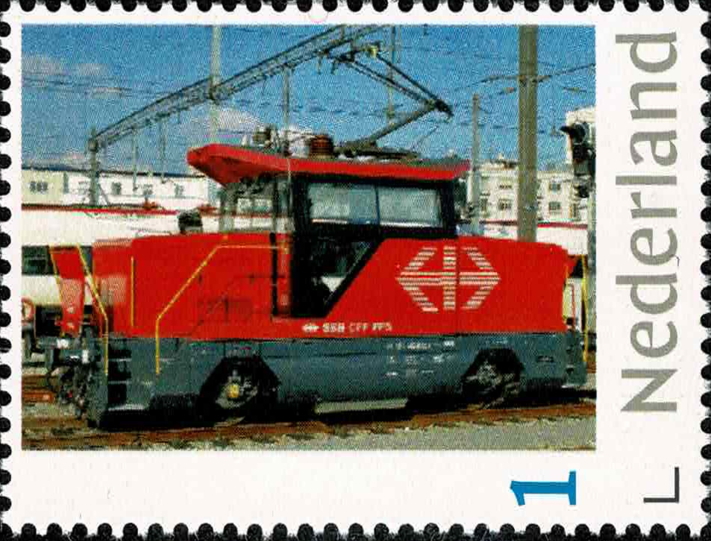
 
.jpg)
 affiche.jpg) |
years unknown: These personalized stamps of Swiss locomotives show the following types: SBB-CFF Ee 3/3 '16454', SBB Ee 922 Stadler and SBB Cargo Eem 923 001-2 in the upper row. SBB Cargo Am 840 001-2, Trans Europ Express (1957-1987) and a poster with Trans Europ Express in the lower row. No entry in official catalogue |
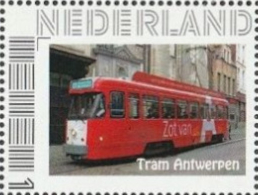 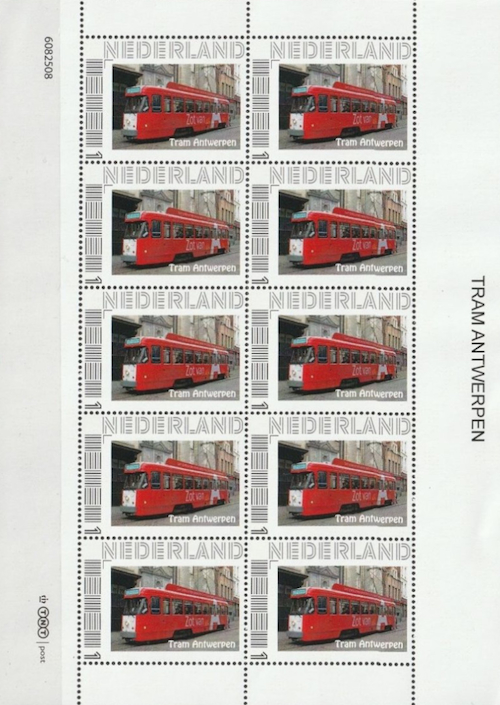 |
2010: Personalized stamp of an Antwerp tram: The Antwerp tram forms the backbone of public transport in the city of Antwerp. The tram network is 75 kilometers long and includes fourteen tram lines in seven of the nine districts and seven adjacent municipalities of the city of Antwerp. The trams cross Antwerp, Boechout, Borsbeek, Melsele, Mortsel, Wijnegem, Wommelgem and Zwijndrecht. This makes it the second largest tram network in Belgium, after that of Brussels. The Antwerp tram network has a track gauge of 1,000 mm, the overhead line voltage is 600 volts. The tram network is only suitable for one-way trams due to the lack of overflow switches and counter-track signals in the pre-metro. Since July 1, 2019, only two-way trams have been running on tram line 12. No entry in official catalogue |
 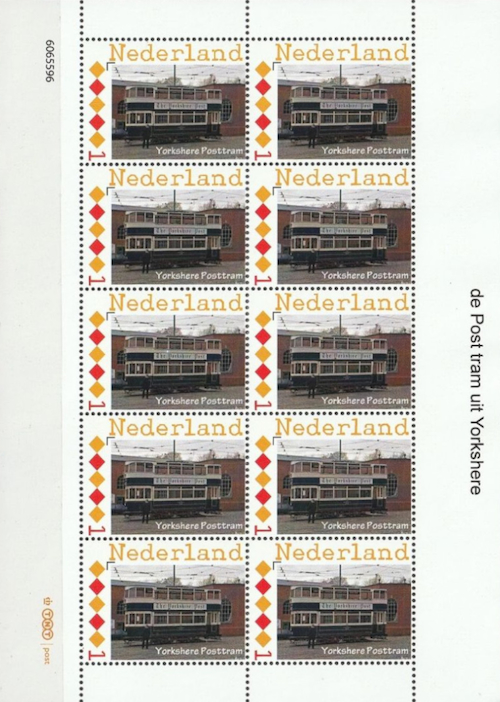 |
2010: Personalized stamp of a Yorkshire mail tram, but it seems more like a Blackpool historic tram. misspelling Yorkshire doesn't inspire much confidence either. No entry in official catalogue |
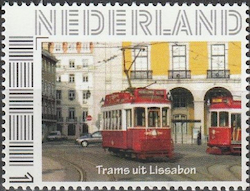 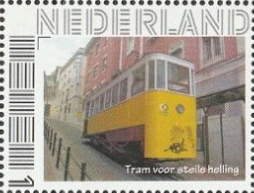 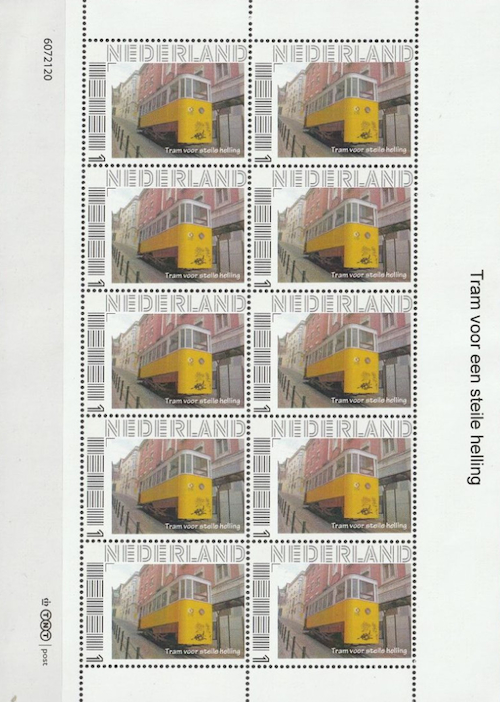 |
2010: Personalized stamp of a Lisbon tram: On August 31, 1901, the first electric tram line was taken into use and a year later the last horse tram line was already discontinued. In 1913 the last cable tramway also disappeared. The electric tram network continued to grow until the opening of the metro in 1959. The network then had 27 lines, of which lines 10/11, 25/26 and 29/30 were ring lines with a separate line number for each direction. The length of the network was 145 kilometers at its peak and there were 419 power cars and 100 trailers. In the years that followed, the metro and bus increasingly took over the transport function of the trams and large parts of the tram network were closed down. For example, in 1988 there were still 14 lines in operation (Line 3, 10, 12, 15, 16, 17, 18, 19, 20, 24, 25/26, 27, 28 and 29/30), in 1991 there were ten more, and five more in 1998. Line 24E was put back into service in 2018, bringing the number of lines to six. In large parts of the city, the abandoned tram tracks are still present in the road surface. The tourist importance of the tram increased, so closing the entire network is no longer an issue. In addition, the trams often run through such narrow streets that bus transportation is hardly possible. No entry in official catalogue |
 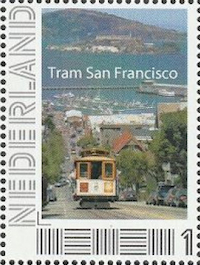 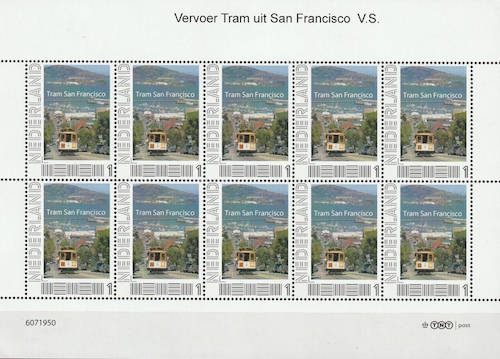 |
2010: Personalized stamp of a San Francisco tram: The hills in San Francisco are too steep for a normal streetcar to run. That is why there are cable cars that grab onto cables that move through a slot between the rails under the ground. Normal trams and express trams also run in the flat streets. The San Francisco cable car is the last manually operated cable car still in use and symbolizes the Californian city of San Francisco. San Francisco's cable cars, along with New Orleans' classic streetcars, are the only moving National Historic Landmarks. No entry in official catalogue |
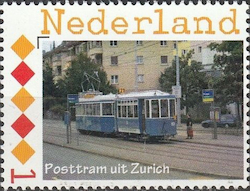 |
2010: Personalized stamp of a Zurich mail tram: Zurich has a dense and efficient public transport network consisting of (trolley) buses, trams and the S-Bahn, the network of regional trains. In addition, the city has 4 mountain railways: the Polybahn and Seilbahn Rigiblick (funicular railways), the Uetlibergbahn (standard gauge) and the Dolderbahn (cogwheel railway). No entry in official catalogue |
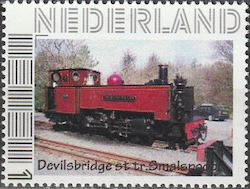 |
2010: Personalized stamp of a narrow gauge locomotive at Devil's Bridge (Wales): The Vale of Rheidol Railway re-creates the Edwardian spirit of adventure. Step aboard one of our restored steam trains for a stunning journey along the Rheidol Valley. Since opening in 1902, millions have enjoyed the scenic trip through the ancient woodlands to Devil's Bridge, home of the famous waterfalls (separate attraction, fee applies), nestled in the astounding Cambrian Mountains. No entry in official catalogue |
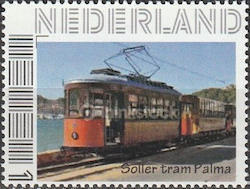 |
2010: Personalized stamp of a tram in Palma: The Soller tramway line, which was designed and constructed by the engineer Pedro Garau, opened on 4 October 1913 shortly after the inauguration of Palma-Sóller rail line, and started regular service on 13 October of that year. Electrified from the start of operation, the line is 4.868 km long, has a single track with passing loops and runs on 3 ft (914 mm) narrow gauge tracks. It is a popular tourist attraction, especially since the early 2000s, as it uses attractive heritage rolling stock. In 2010 it carried approximately 900,000 passengers. br> No entry in official catalogue |
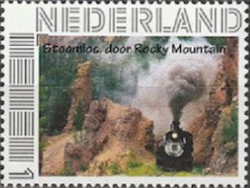 |
2010: Personalized stamp of a Rocky Mountains steam locomotive: The Durango & Silverton Narrow Gauge Railroad provides scenic rides for tourists. No entry in official catalogue |
 |
2010: Personalized stamp of a few Vienna trams: The first electric tram line in Vienna was opened on January 28, 1897 and covered a large part of the current line 5. Due to the fact that the electric tram was a much lesser burden on city life than the horse or steam tram, a very large tram network built. The last horse-drawn tram line was already running in 1903. A few peripherally located steam tram lines survived until 1922. For economic reasons, the conductors were gradually abolished from 1964 in the trailers and from 1972 in the railcars. However, it took until 1996 before this was fully implemented, line 46 was the last to have conductors. During the construction of various metro lines, tram lines were frequently diverted and/or discontinued after commissioning. There is no discussion in Vienna about the idea that a tram line above ground and a metro underground do not compete with each other, but have a reinforcing effect on each other, but this has been ruled out. The cancellation of lines 52 and 58 in Mariahilfer Straβe is particularly regrettable. No entry in official catalogue |
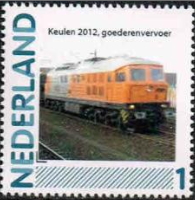
 
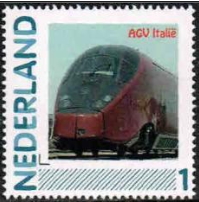 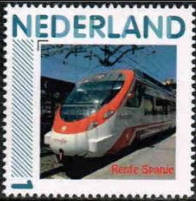
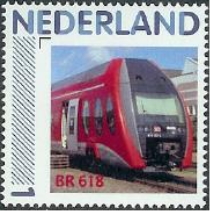 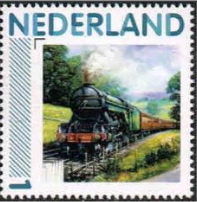
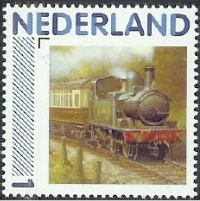
|
2011: Personalized stamps in a square frame: Goods loco in the Cologne area in Germany + a German ICE3. German Lufthansa ET 403 + Italian AGV. Spanish RENFE loco + British Rail 618 Two UK steam locomotives, on the left: Flying Dutchman. No entry in official catalogue |


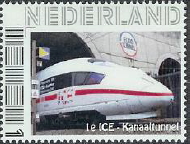 

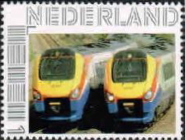
|
2011: Set of six personalized stamps with foreign High Speed Trains: Eurostar, ICE and British Rail. No entry in official catalogue |
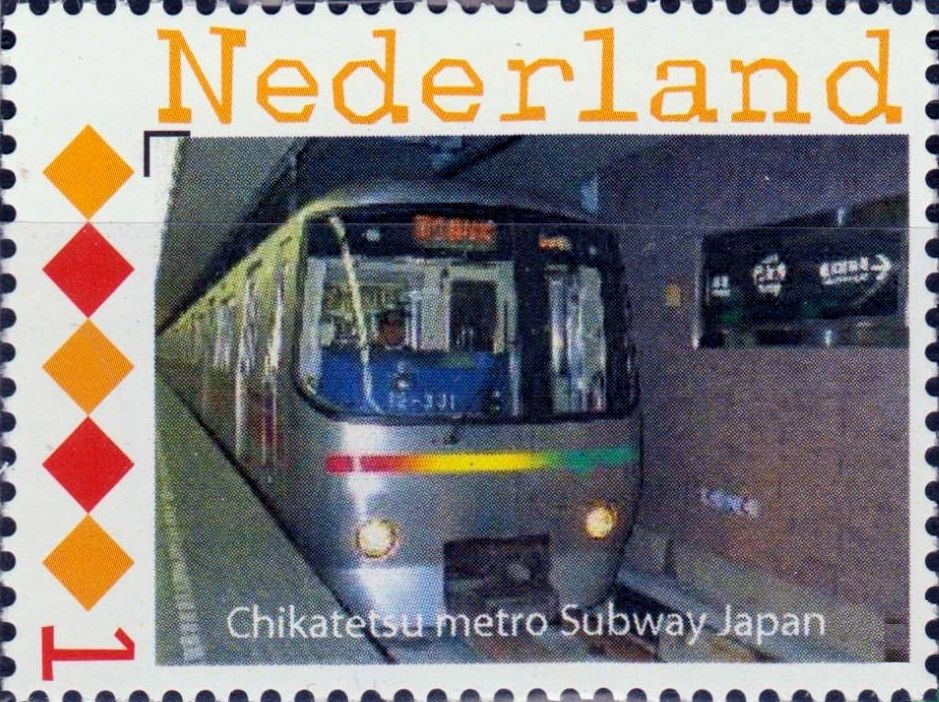
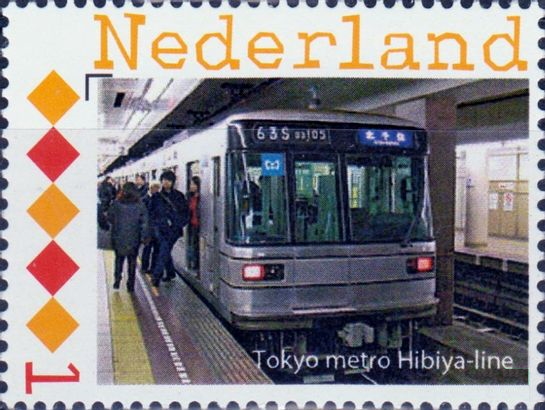 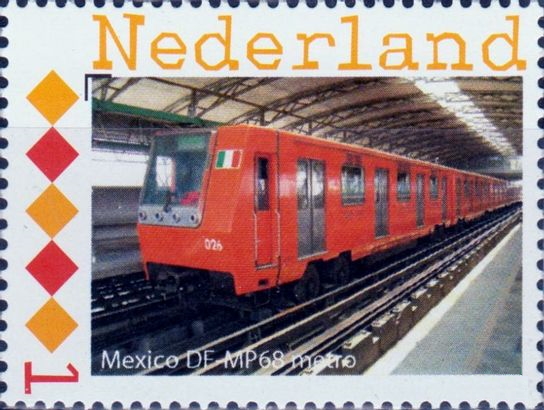
 
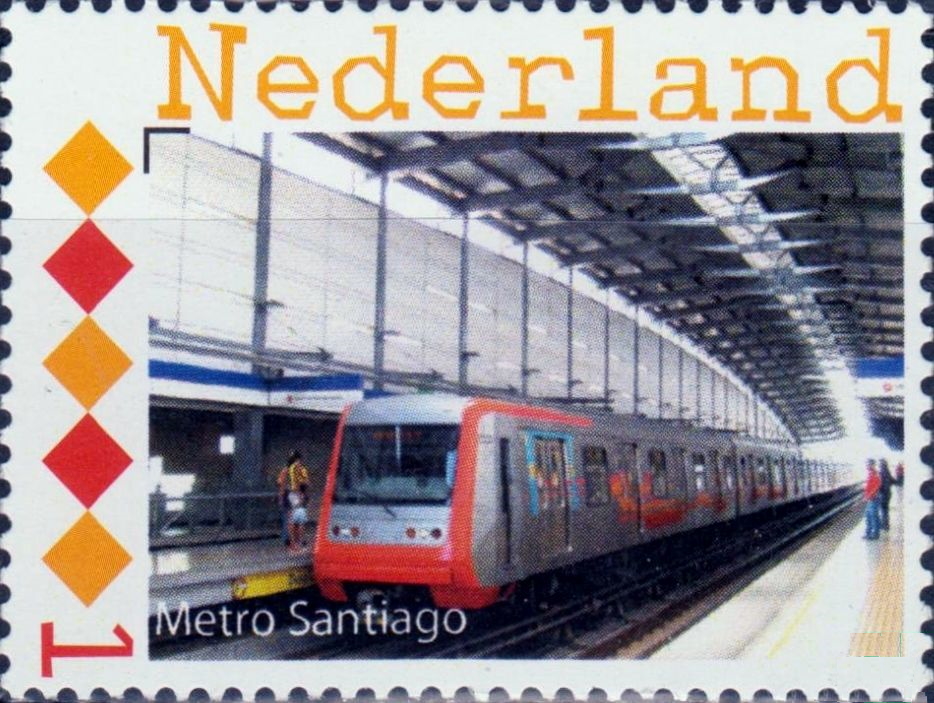 
|
2011: Several foreign Metro Trains: Chikatetsu in Japan + Tokyo in Japan Mexico City + Milano in Italy Paris, France + Santiago in Chile Warsaw in Poland No entry in official catalogue |
 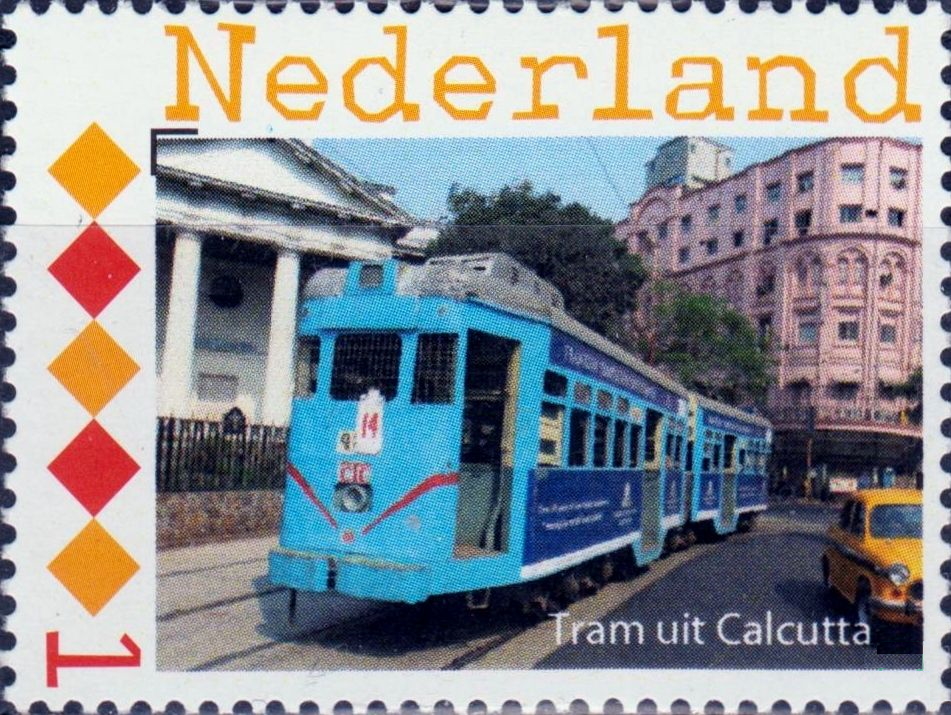
 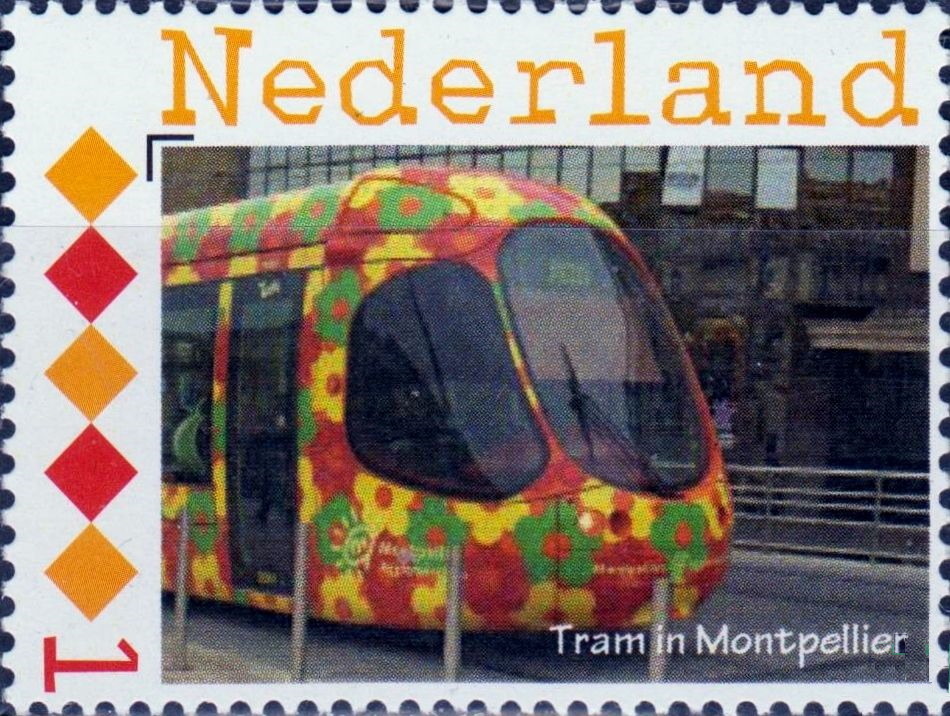
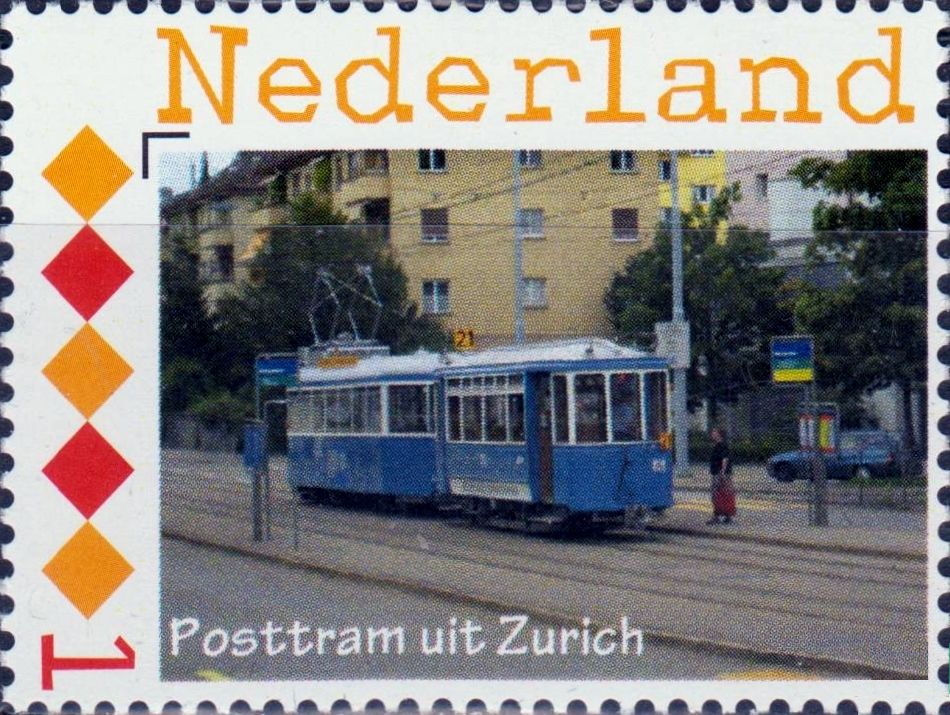 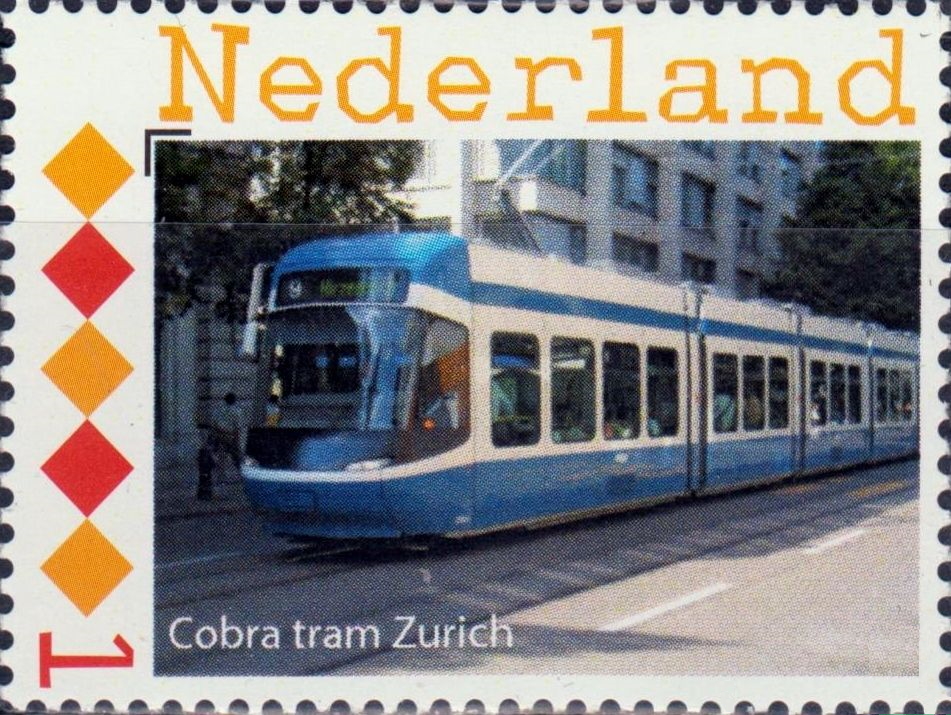
|
2011: Several foreign Trams: Budapest in Hungary Calcutta in India + London in Great-Britain Montpellier in France + Zurich in Switzerland Cobra tram in Zurich in Switzerland No entry in official catalogue |
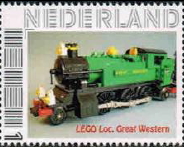
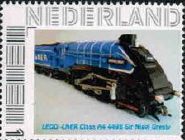
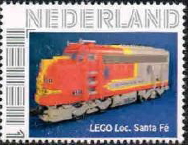 
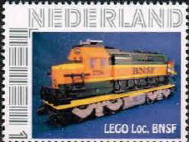
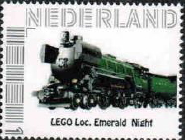
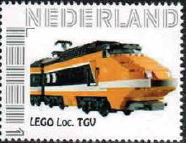
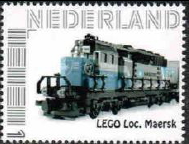
|
2011 (?): Set of eight personalized stamps with foreign Lego trains: Great Western Railway + LNER A4 Pacific "Sir Nigel Gresley" + Santa Fe MAERSK loco + BNSF loco + "Emerald Night" TGV + MAERSK loco No entry in official catalogue |
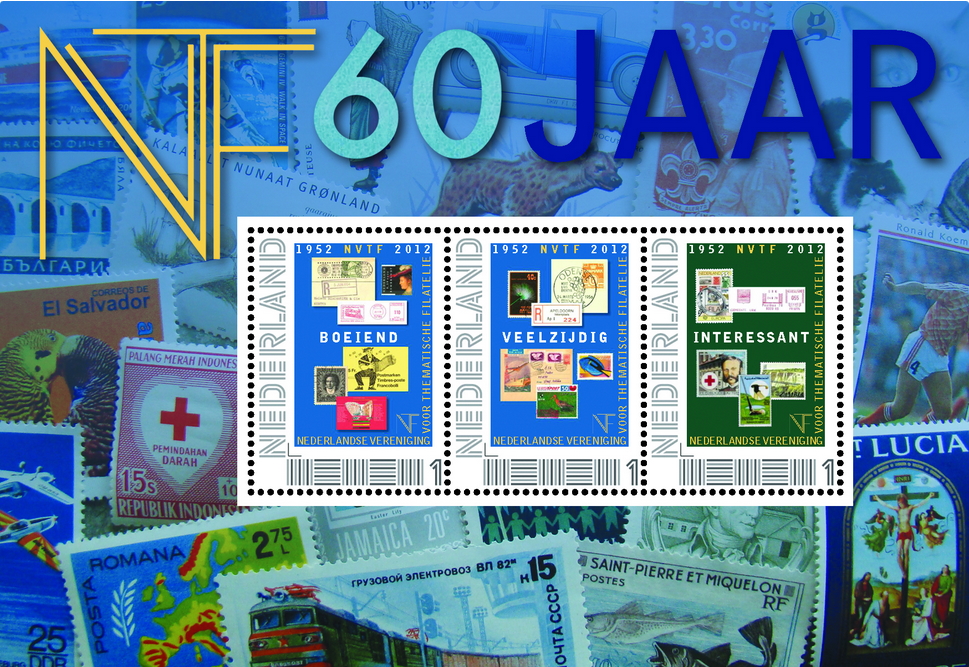 |
2012: Sheet of personalised stamps of the Dutch Association of Thematic Philately (NVTF) In commemoration of their sixtieth anniversary the Dutch Association of Thematic Philately (NVTF) issued a sheet of three personalised stamps. In the border you find a 1982 Russian stamp from a set of 5 showing an electic locomotive. Catalogue of personalized stamps from The Netherlands: 2751-D-29 |
 |
2013: An Italian work locomotive: Fer 80 Srl. No entry in official catalogue |
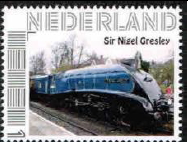

 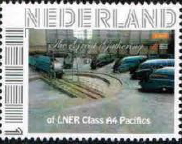
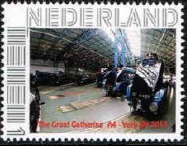
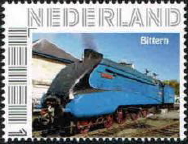 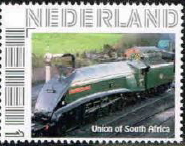
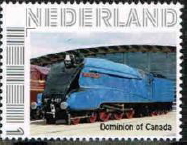

|
2013: The Great Gathering of A4 Pacifics in York (UK). The Great Gathering was an exhibition of all the surviving LNER Class A4s at the National Railway Museum in York in July 2013. The following locos were present: 4464 Bittern 4468 Mallard 4498 Sir Nigel Gresley 60008 Dwight D Eisenhower 60009 Union of South Africa 60010 Dominion of Canada No entry in official catalogue |
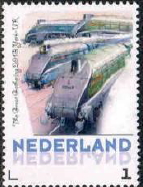
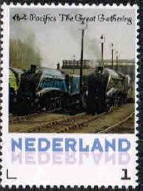
|
2014: Again The Great Gathering of A4 Pacifics in York (UK). This time two stamps. No entry in official catalogue |
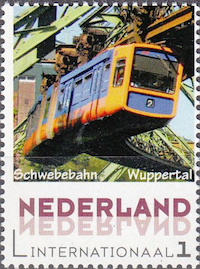
|
unknown year: The Wuppertaler Schwebebahn (Wuppertal Suspension Railway) in the German city of Wuppertal is the oldest electric elevated railway with hanging cars in the world and is a unique system in Germany. Designed by Eugen Langen and offered first to the cities of Berlin, Munich, and Breslau who all turned it down, the installation with elevated stations was built in Barmen, Elberfeld, and Vohwinkel between 1897 and 1903; the first track opened in 1901. The railway line is credited with growth of the original cities and their eventual merger into Wuppertal. The Schwebebahn is still in use as a normal means of local public transport, moving 25 million passengers annually, per the 2008 annual report. New rail cars were ordered in 2015, called Generation 15, and the first new car went into service in December 2016. The Schwebebahn runs along a route of 13.3 kilometres (8.3 mi), at a height of about 12 metres (39 ft) above the River Wupper. No entry in official catalogue |
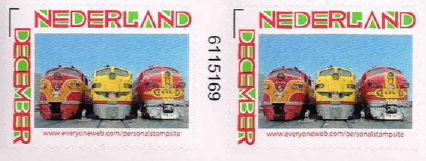
 
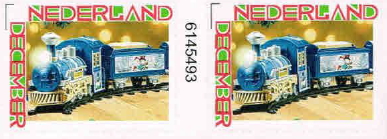 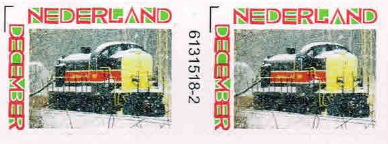
 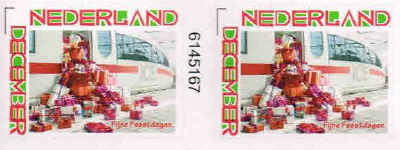
|
several unknown years: stamps from rolls with foreign locos: Three US locos + ICE Wuppertal suspension train + Christmas train US loco + ICE ICE Christmas train No entry in official catalogue |
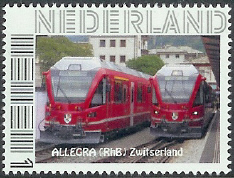 |
2015: Stamp made by C.F. Riem with an Allegra train from the Rhätische Bahn in Switzerland. The Rhaetian Railway ABe 8/12, which is also known as the Allegra, is a class of dual voltage metre gauge three car multiple unit trains of the Rhaetian Railway (RhB), which is the main railway network in the Canton of Graubünden, Switzerland. The class is so named under the Swiss locomotive and railcar classification system. According to that system, ABe 8/12 denotes an electric railcar train with first and second class compartments, and a total of 12 axles, eight of which are drive axles. The ABe 8/12 trains were delivered between 2009 and 2011. They are used mainly on Rhaetian Railway routes with steep inclines: the Arosa line, the Bernina Railway, and the route from Landquart to Davos. They are fitted with dual voltage electrical equipment, to enable them to operate on both the Rhaetian Railway's core network, which is electrified at 11 kV 16.7 Hz, and on the Bernina Railway, which is electrified at 1,000 V DC. Each of the ABe 8/12s is equipped with comfortable air conditioned compartments for both first class and second class passengers. The first class compartment at the front of each train offers a pleasant view of the track from directly behind the driver. In the middle of the ABe 8/12s is a large low floor area, which also allows disabled passengers a comfortable ride. Most units entered regular service soon after delivery. On 5 December 2009, during regular pre-service shakedown trials in the Vereina Tunnel, an ABe 8/12 set a new speed record for metre gauge railways of 139 km/h. The previous record had stood at 134 km/h, and had been held by the Regionalverkehr Bern-Solothurn (RBS). The maximum speed previously registered on the RhB had been 110 km/h. No entry in official catalogue |
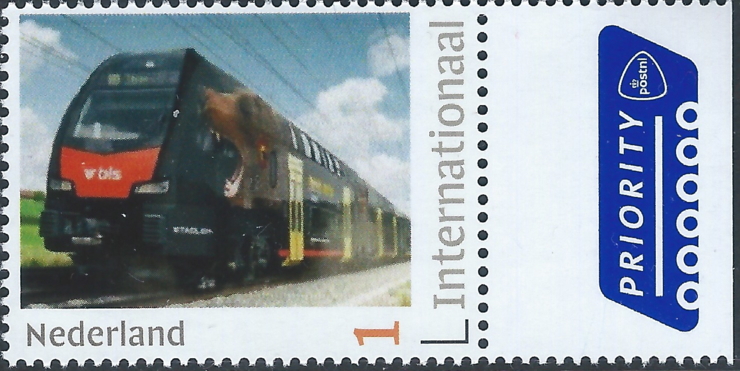 |
2018: The BLS MUTZ Doppelstock from Switzerland. No entry in official catalogue |

|
2019: A series of five Swiss railway posters was issued on personalised stamps, showing: The Jura-Simplon Railway, the Montreux-Berner Oberland Railway (three times) and the electric Simplon Line. No entry in official catalogue |
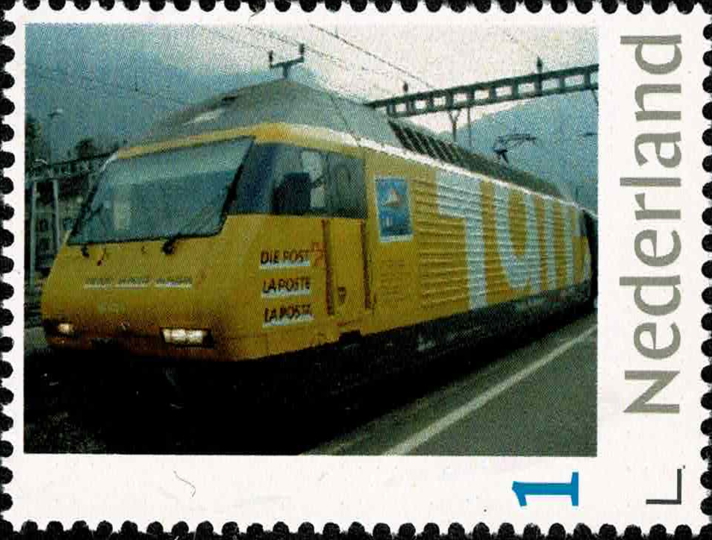

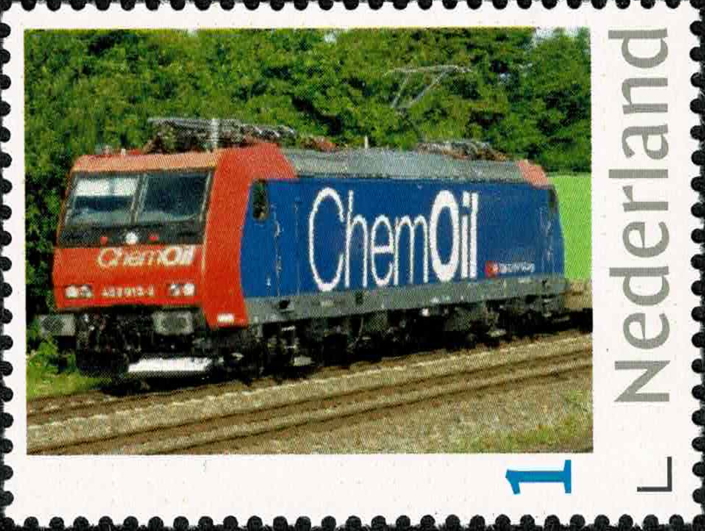 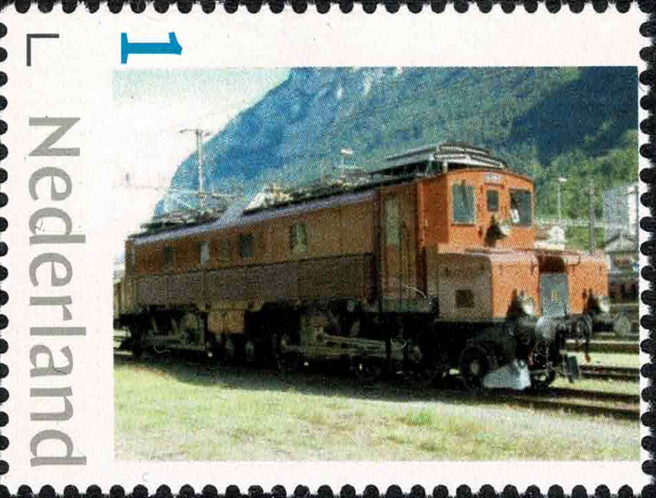
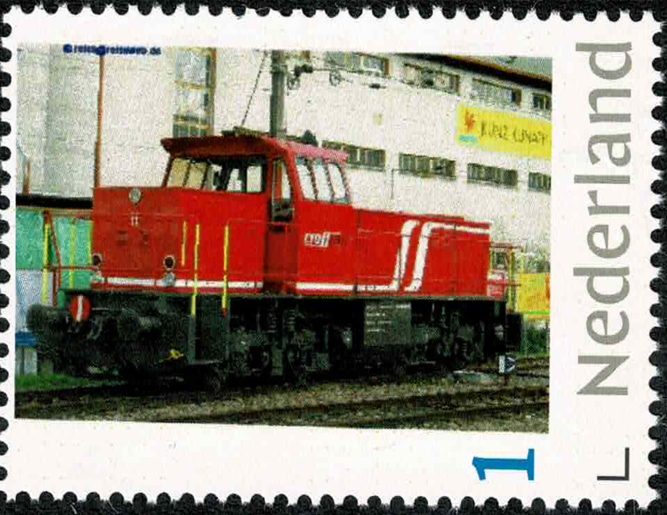
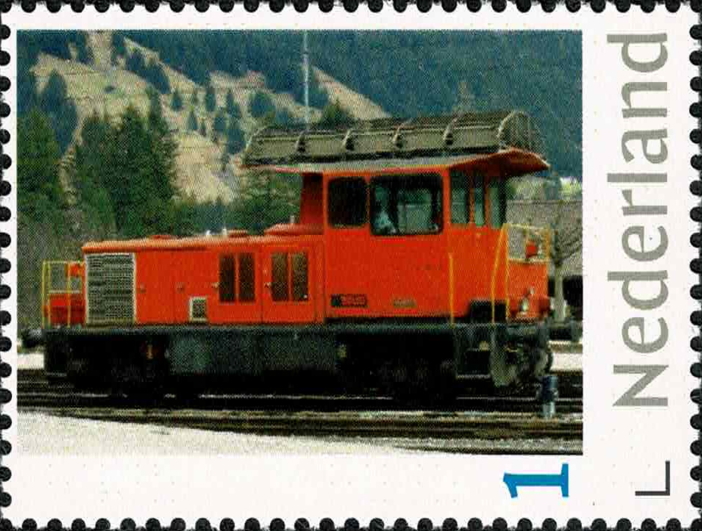 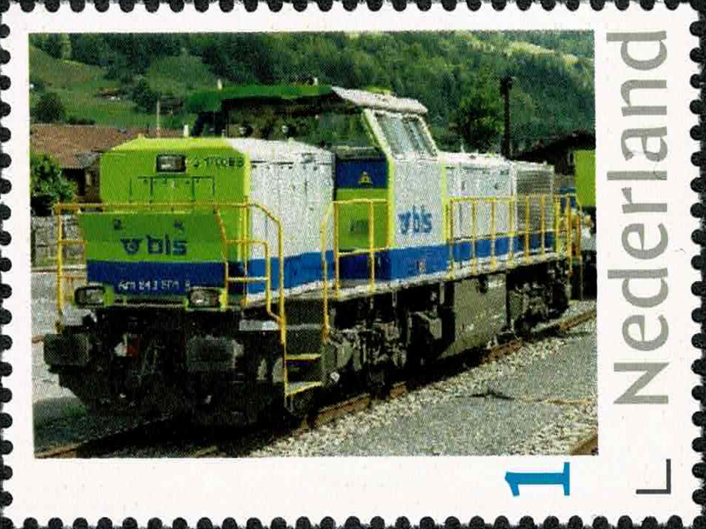
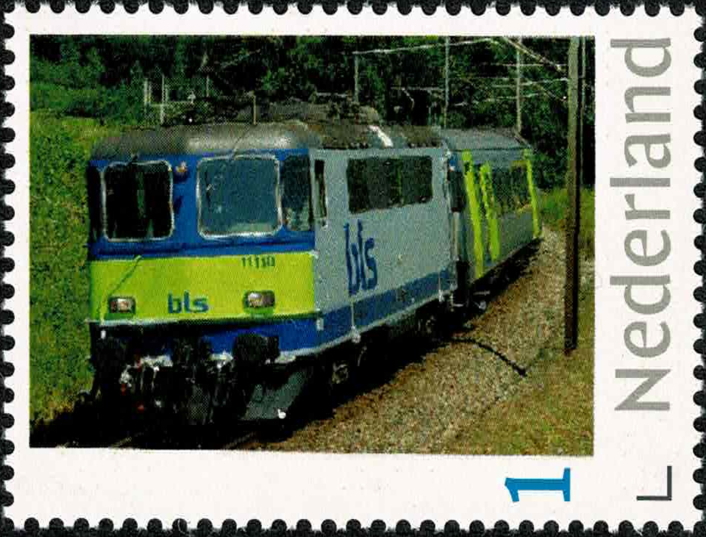
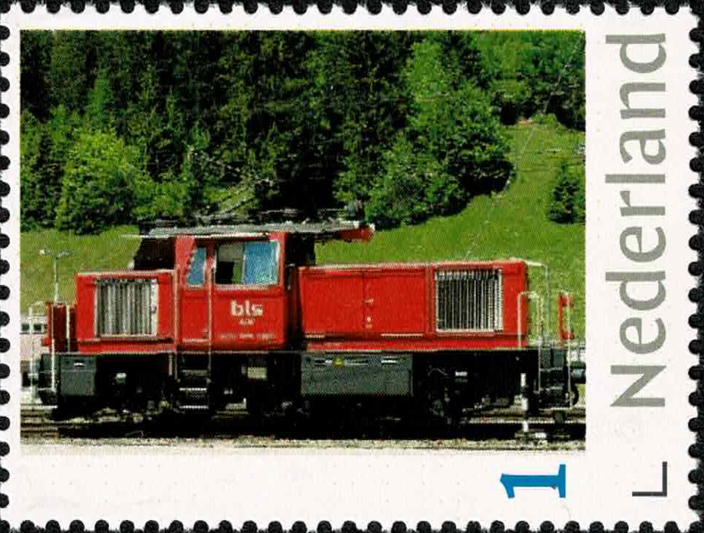 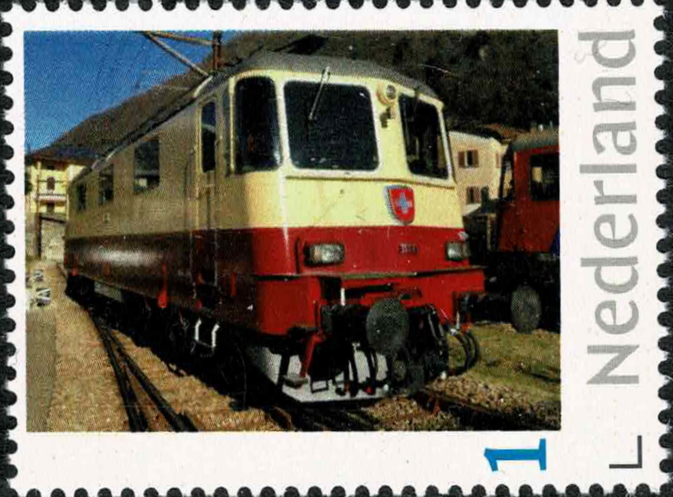
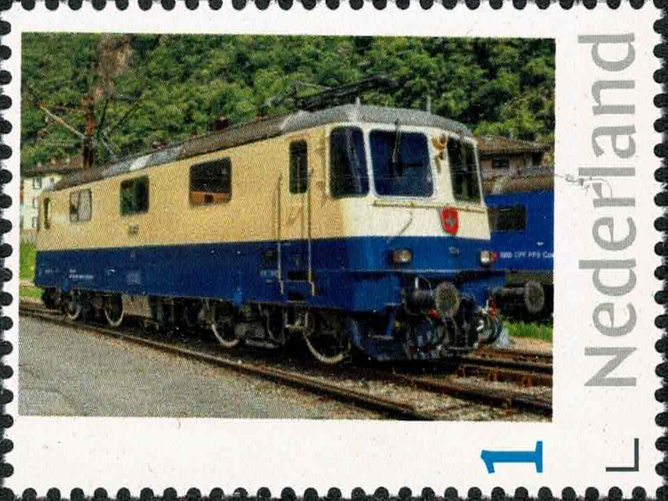
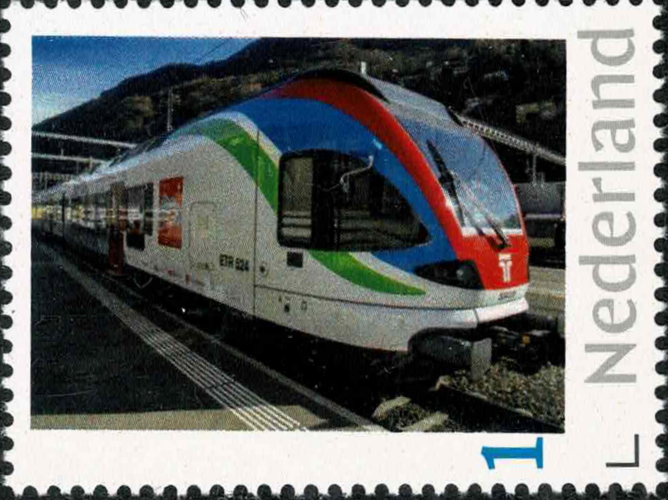 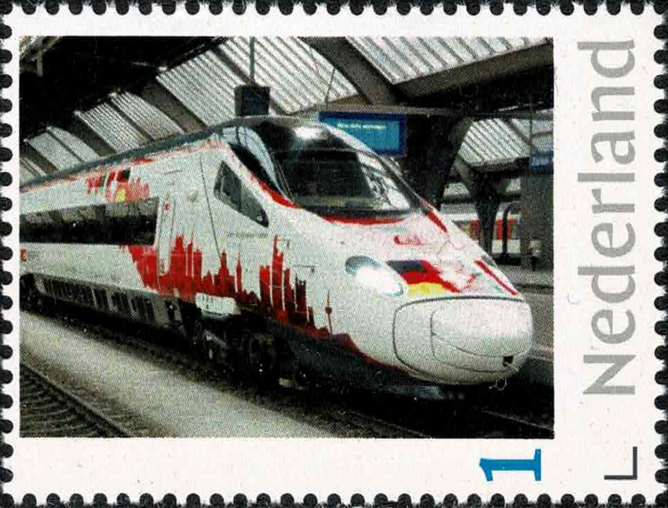
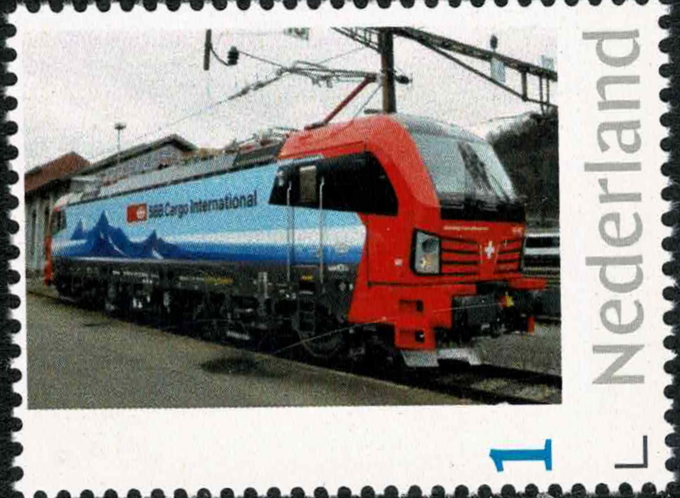
 
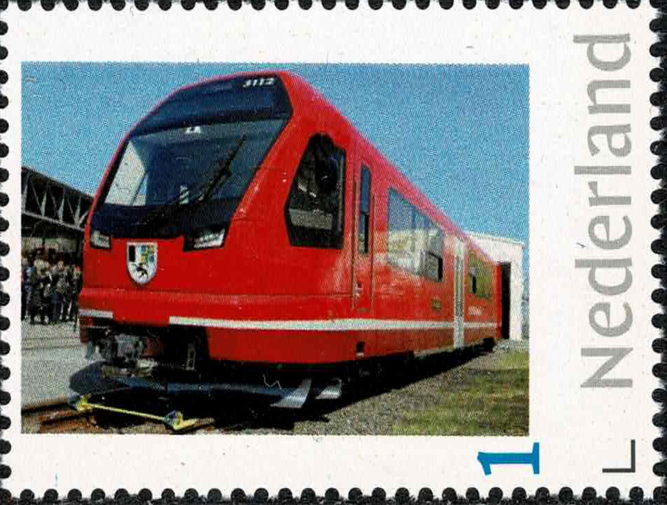
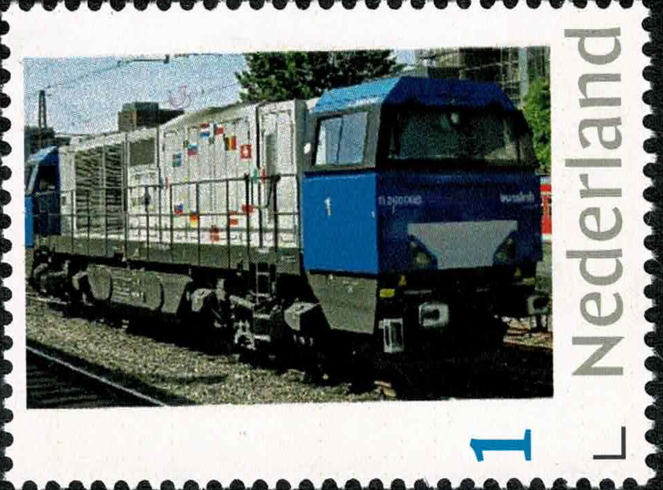 |
2019: A number of Swiss locomotives was issued on personalised stamps, showing: First row: SBB Re 460 La Poste, SBB Ee 922 Stadler and SBB ChemOil Bombardier. Second row: SBB Ce 6-8 14201 Köfferli, CrossRail and BLS Tm 235 100-5. Third row: BLS Am 843 501-8, BLS 11110 Ae 4-4 and BLS 402. Fourth row: SBB TEE Re 4-4 IRIS 1985, SBB IRIS Re 4-4 421 387 Rheingold and SBB CFF FFS Tilo Flirt RABe 524 015. Fifth row: SBB CFF FFS RABe 503 022 Trinational Germany-Switzerland-Italy, SBB cargo International Vectron193-461 and SBB Ae 3-6 II 10439. Sixth row: BLS Flirt 3 by Stadler, Rhätische Bahn Capricorn by Stadler and German built Vossloh G2000BB. No entry in official catalogue |
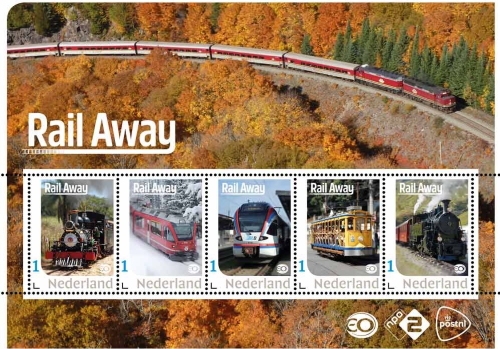
|
1st August 2019: Postal stationery set of 5 picture postcards and 1 stamp sheet of personalized stamps about the Dutch television series Rail Away. In this travel programme, striking railway lines from all over the world are shown. Each episode a route is followed along a number of special locations, where the train serves as a guideline. Not only attention is paid to the trains and railway lines themselves, but also to the landscape, cities, culture and history. Available through Collect Club of the Dutch PostNL company. Catalogue of personalized stamps from The Netherlands: ?? |
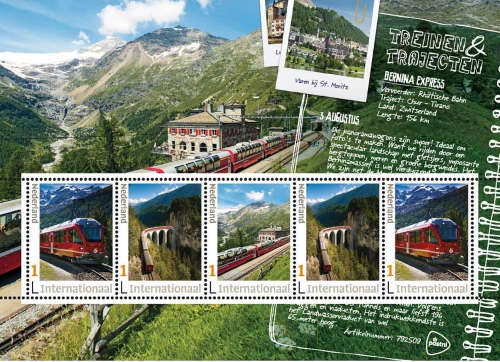
|
5th November 2019: PostNL published a series of stamp sheets focusing on 25 unique train routes around the world, among others: Bernina Express. The Bernina railway is a single-track 1,000 mm (3 ft 3 3/8 in) metre gauge railway line forming part of the Rhaetian Railway (RhB). It links the spa resort of St. Moritz, in the Canton of Graubünden, Switzerland, with the town of Tirano, in the Province of Sondrio, Italy, via the Bernina Pass. Reaching a height of 2,253 metres (7,392 ft) above sea level, it is the highest railway crossing in Europe and the third highest railway in Switzerland. It also ranks as the highest adhesion railway of the continent, and - with inclines of up to 7% - as one of the steepest adhesion railways in the world. The height difference on the section between the Bernina Pass and Tirano is 1,824 m (5,984 ft), allowing passengers to see glaciers and palm trees on the same line. [source: wikipedia] Catalogue of personalized stamps from The Netherlands: 3644-1-04 |
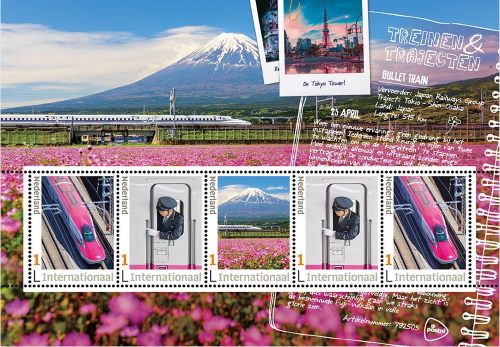
|
5th November 2019: PostNL published a series of stamp sheets focusing on 25 unique train routes around the world, among others: the Bullet Train. The Shinkansen (lit. 'new trunk line'), colloquially known in English as the bullet train, is a network of high-speed railway lines in Japan. Initially, it was built to connect distant Japanese regions with Tokyo, the capital, in order to aid economic growth and development. Beyond long-distance travel, some sections around the largest metropolitan areas are used as a commuter rail network. It is operated by five Japan Railways Group companies. Over the Shinkansen's 50-plus year history, carrying over 5.3 billion passengers, there has been not a single passenger fatality or injury due to train accidents. The Tokaido Shinkansen began service on 1 October 1964. The conventional Limited Express service took six hours and 40 minutes from Tokyo to Osaka, but the Shinkansen made the trip in just four hours, shortened to three hours and ten minutes by 1965. As of 2014, the train's 50th anniversary, daily passenger traffic had risen to 391,000 which, spread out over its 18-hour schedule, represented an average of just under 22,000 passengers an hour. The first Shinkansen trains, the 0 series, ran at speeds of up to 210 km/h (130 mph), later increased to 220 km/h (137 mph). The last of these trains, with their classic bullet-nosed appearance, were retired on 30 November 2008. [source: wikipedia] Catalogue of personalized stamps from The Netherlands: 3644-1-02 |
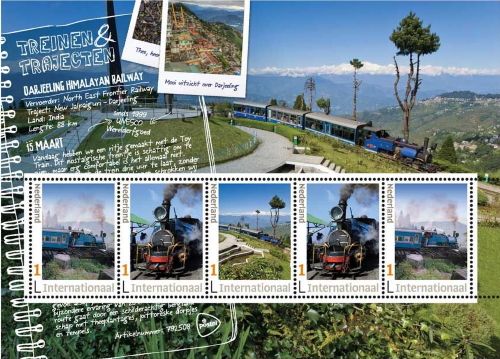
|
5th November 2019: PostNL published a series of stamp sheets focusing on 25 unique train routes around the world, among others: Darjeeling Himalayan Railway. The Darjeeling Himalayan Railway, also known as the DHR or the Toy Train, is a 2 ft (610 mm) gauge railway that runs between New Jalpaiguri and Darjeeling in the Indian state of West Bengal. Built between 1879 and 1881, it is about 88 km (55 mi) long. It climbs from about 100 m (328 ft) above sea level at New Jalpaiguri to about 2,200 m (7,218 ft) at Darjeeling, using six zig zags and five loops to gain altitude. Six diesel locomotives handle most of the scheduled service, with daily tourist trains from Darjeeling to Ghum - India's highest railway station - and the steam-hauled Red Panda service from Darjeeling to Kurseong. Steam-enthusiast specials are hauled by vintage British-built B-Class steam locomotives. The railway's headquarters are at Kurseong. [source: wikipedia] Catalogue of personalized stamps from The Netherlands: 3644-1-03 |

|
5th November 2019: PostNL published a series of stamp sheets focusing on 25 unique train routes around the world, among others: Pride of Africa. The Pride of Africa is a luxury train which is run by Rovos Rail. It is the world's most luxurious train according to Rovos Rail. It travels through South Africa, Zimbabwe, Zambia and Tanzania. [source: wikipedia] Catalogue of personalized stamps from The Netherlands: 3644-1-05 |
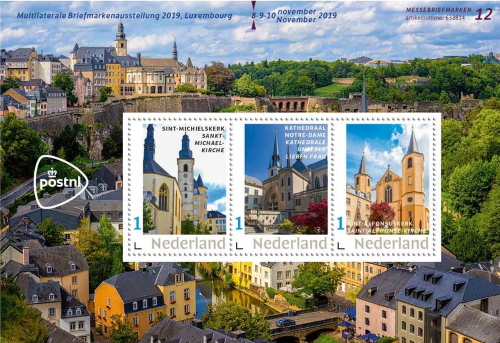
|
8th November 2019: Stamp sheet of personalized stamps issued on the occasion of the international stamp exhibition Multilateral 2019 in Luxemburg. On the edge of the sheet, above the stamps, you can see the Passerelle, also known as Luxemburg viaduct. The bridge is 290 meters long, consists of 24 arches and is located 45 meters above the bottom of the valley. Catalogue of personalized stamps from The Netherlands: ?? |
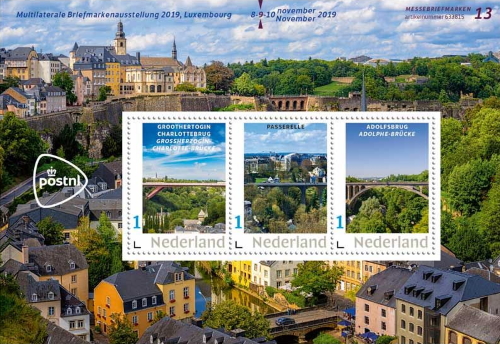
|
8th November 2019: This sheet shows Adolphe Bridge on the stamp on the right. The Adolphe Bridge is a double-decked arch bridge in Luxemburg City, in southern Luxemburg. The bridge provides a one-way route for road traffic across the Pétrusse, from Boulevard Royal, in Ville Haute, to Avenue de la Liberté, in Gare. Its upper deck is 153 m in length and carries two lanes of road traffic, and two pedestrian footpaths. Its lower deck, opened in 2018, suspended beneath the upper deck, is 154 m in length, and carries a dedicated bidirectional bicycle path, with access provided for pedestrian use. Following the completion of the third phase of the construction of the City Tram Line 1, expected in 2020, the bridge will carry bidirectional tram traffic on its upper deck. [source: wikipedia] On the edge of the sheet, above the stamps, you can see the Passerelle, also known as Luxemburg viaduct. The bridge is 290 meters long, consists of 24 arches and is located 45 meters above the bottom of the valley. Catalogue of personalized stamps from The Netherlands: ?? |
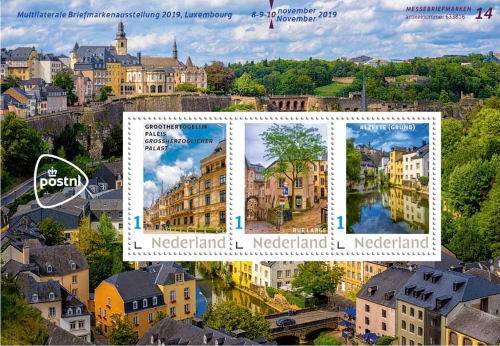
|
8th November 2019: On the edge of the sheet, above the stamps, you can see the Passerelle, also known as Luxemburg viaduct. The bridge is 290 meters long, consists of 24 arches and is located 45 meters above the bottom of the valley. Catalogue of personalized stamps from The Netherlands: ?? |

|
21st January 2020: PostNL published a series of stamp sheets focusing on 25 unique train routes around the world, among others: PeruRail, a railway operator providing tourist, freight, and charter services in southern Peru. It was founded in 1999 by two Peruvian entrepreneurs and British company Sea Containers. The main line between the port of Matarani, Arequipa, Cusco and Puno on Lake Titicaca was formerly known as the Ferrocarril del Sur, and was for a time owned and operated by the ENAFER state company. It is the third highest railway in the world after the Qinghai-Tibet Railway to Tibet and the FCCA line from Lima to Huancayo, and is the longest line in Peru. From Cusco, PeruRail provides passenger services on the 3 ft (914 mm) gauge Ferrocarril Santa Ana to Aguas Calientes, delivering tourists for Machu Picchu. [source: wikipedia] Catalogue of personalized stamps from The Netherlands: 3644-1-11 |
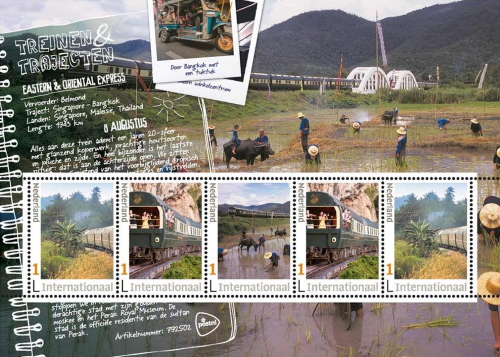
|
17th February 2020: PostNL published a series of stamp sheets focusing on 25 unique train routes around the world, among others: Eastern & Oriental Express. The Eastern & Oriental Express is a luxury train that carries passengers between Singapore, Malaysia, and Thailand. It runs between Singapore's Woodlands Train Checkpoint and Hua Lamphong, Bangkok, stopping at Kuala Lumpur, Butterworth, and Kanchanaburi, taking three days (two nights). Since 2007 the train has also travelled between Bangkok and Vientiane, the capital city of Laos. The train is operated by Belmond Ltd. It runs several times a month most of the year. [source: wikipedia] Catalogue of personalized stamps from The Netherlands: 3644-1-07 |
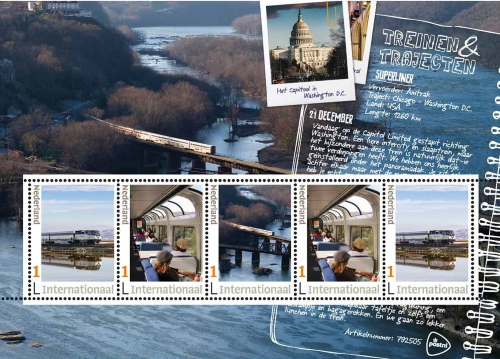
|
17th February 2020: PostNL published a series of stamp sheets focusing on 25 unique train routes around the world, among others: Superliner. The Superliner is a type of bilevel intercity railroad passenger car used by Amtrak, the national rail passenger carrier in the United States. Amtrak ordered the cars to replace older single-level cars on its long-distance trains in the Western United States. The design was based on the Budd Hi-Level vehicles, employed by the Santa Fe Railway on its El Capitan trains. Pullman-Standard built 284 cars, known as Superliner I, from 1975 to 1981; Bombardier Transportation built 195, known as Superliner II, from 1991 to 1996. The Superliner I cars were the last passenger cars built by Pullman. Car types include coaches, dining cars, lounges, and sleeping cars. Most passenger spaces are on the upper level, which features a row of windows on both sides. The Sightseer Lounge observation cars have distinctive floor-to-ceiling windows on the upper level. Boarding is on the lower level; passengers climb up a center stairwell to access the upper level. The first Superliner I cars entered service in February 1979, with deliveries continuing through 1981. Amtrak assigned the cars to both long-distance and short-distance trains in the Western United States. [source: wikipedia] Catalogue of personalized stamps from The Netherlands: 3644-1-06 |
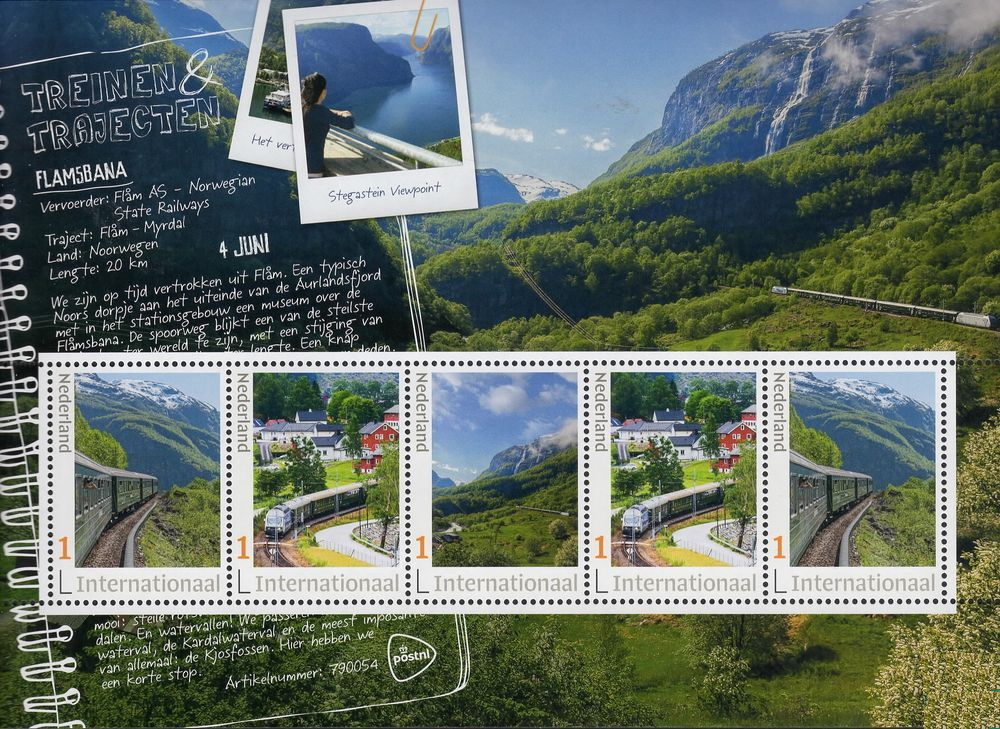
|
4th June 2020: PostNL published a series of stamp sheets focusing on 25 unique train routes around the world, among others: Flåmsbana. The Flåm Line (Norwegian: Flåmsbana) is a 20.2-kilometer (12.6 mi) long railway line between Myrdal and Flåm in Aurland Municipality, in Vestland county, Norway. A branch line of the Bergen Line, it runs through the valley of Flåmsdalen and connects the mainline with Sognefjord. The line's elevation difference is 866 meters (2,841 ft); it has ten stations, twenty tunnels and one bridge. The maximum gradient is 5.5 percent (1:18). Because of its steep gradient and picturesque nature, the Flåm Line is now almost exclusively a tourist service and has become the third-most visited tourist attraction in Norway. Construction of the line started in 1924, with the line opening in 1940. It allowed the district of Sogn access to Bergen and Oslo via the Bergen Line. Electric traction was taken into use in 1944; at first El 9 locomotives were used, and from 1982 El 11. Until 1991, the train connected with a ferry service from Flåm to Gudvangen. In 1992, freight services were terminated, and due to low ticket prices and high operating costs, the line was nearly closed. In 1998, Flåm Utvikling took over marketing and ticket sale for the line, prices were heavily increased and El 17 locomotives were introduced. The trains remain operated by the Norwegian State Railways (NSB), while the line itself is owned and operated by the Norwegian National Rail Administration. [source: wikipedia] Catalogue of personalized stamps from The Netherlands: 3644-1-15 |
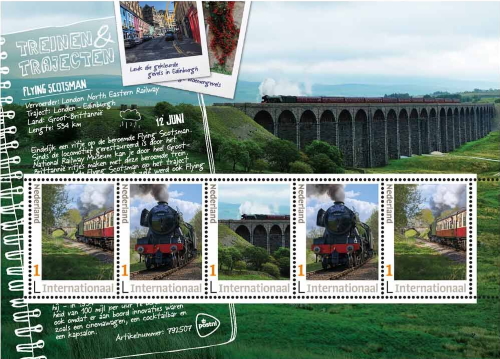
|
12th June 2020: PostNL published a series of stamp sheets focusing on 25 unique train routes around the world, among others: the Flying Scotsman. The Flying Scotsman is an express passenger train service that has operated between Edinburgh and London, the capitals of Scotland and England, via the East Coast Main Line. The service began in 1862; the name was officially adopted in 1924. It is currently operated by London North Eastern Railway. The East Coast Main Line over which the Flying Scotsman runs was built in the 19th century by many small railway companies, but mergers and acquisitions led to only three companies controlling the route; the North British Railway (NBR), the North Eastern Railway (NER) and the Great Northern Railway (GNR). In 1860 the three companies established the East Coast Joint Stock for through services using common vehicles, and it is from this agreement that the Flying Scotsman came about. The Flying Scotsman name has been maintained by the operators of the InterCity East Coast franchise since privatisation of British Rail; the former Great North Eastern Railway even subtitled itself The Route of the Flying Scotsman. The Flying Scotsman was operated by GNER from April 1996 until November 2007, then by National Express East Coast until November 2009, East Coast until April 2015, and Virgin Trains East Coast until June 2018. Since then it has been operated by the government-owned London North Eastern Railway. For the first time in its history, it ran in one direction only: there is no northbound equivalent service. This schedule is maintained today. Northbound, the fastest timetabled London to Edinburgh service now takes 4 hours 19 minutes. LNER's new "Azuma" units (Class 800s and Class 801s) took over the service on 1 August 2019. Since then, this one train is scheduled to run to London in 4 hours exactly. [source: wikipedia] Catalogue of personalized stamps from The Netherlands: 3644-1-09 |

|
12th June 2020: PostNL published a series of stamp sheets focusing on 25 unique train routes around the world, among others: The Ghan. The Ghan is an Australian passenger train service between the cities of Adelaide, Alice Springs and Darwin on the Adelaide-Darwin railway. ' Operated by Journey Beyond Rail Expeditions, it takes 54 hours to travel the 2,979 kilometres (1,851 mi) with a four-hour stopover in Alice Springs. The Ghan is considered to be one of the world's great train journeys. The service's name is an abbreviated version of its previous nickname, The Afghan Express. The nickname is reputed to have been bestowed in 1923 by one of its crews. Some suggest the train's name honours Afghan camel drivers who arrived in Australia in the late 19th century to help the British colonisers find a way to reach the country's interior. A contrary view is that the name was a veiled insult. In 1891, the railway from Quorn reached remote Oodnadatta where an itinerant population of around 150 cameleers were based, generically called "Afghans". "The Ghan Express" name originated with train crews in the 1890s as a taunt to officialdom because, when an expensive sleeping car was put on from Quorn to Oodnadatta, "on the first return journey the only passenger was an Afghan", mocking its commercial viability. The Ghan was privatised in 1997 and has since then been operated by Journey Beyond Rail Expeditions (formerly known as Great Southern Rail), initially as part of the Serco Group. Great Southern Rail was sold to Allegro Funds, a Sydney investment fund, in March 2015. The train usually runs weekly year-round. The train stops at Adelaide, Alice Springs, Katherine and Darwin. Each train has 16 to 38 stainless steel carriages, built by Comeng, Granville, in the late 1960s and early 1970s for the Indian Pacific, plus a motorail wagon. The average length of the train is 774 metres (2,539 ft). A Pacific National NR class locomotive, plus a second locomotive if necessary, usually hauls the train, but occasionally other engines assist, such as an AN class or a DL class locomotive. [source: wikipedia] Catalogue of personalized stamps from The Netherlands: 3644-1-08 |
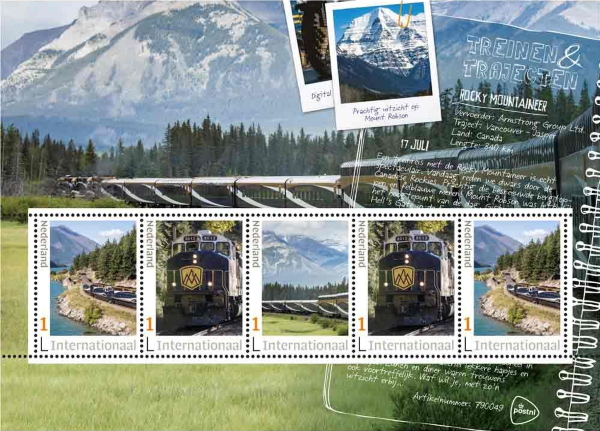
|
17th July 2020: PostNL published a series of stamp sheets focusing on 25 unique train routes around the world, among others: The Rocky Mountaineer. Rocky Mountaineer is a Canadian rail-tour company in Western Canada that operates trains on three rail routes through British Columbia and Alberta. The Rocky Mountaineer began as a weekly VIA Rail daytime service between Calgary, Jasper and Vancouver on June 9, 1988, called the 'Canadian Rockies by Daylight.'. This service was the same as it is today, with an overnight stop in Kamloops. Trains departed Vancouver on Sundays, with trains to Jasper and Calgary (by way of Banff) departing Monday morning. These were express services, with no intermediate stops. Return service began westward on Thursdays from Calgary and Jasper, terminating on Friday in Vancouver. On June 4, 1989, VIA began its second season of the service and renamed the service the 'Rocky Mountaineer.' Scheduling remained the same as the previous season. The final Summer Rocky Mountaineer under VIA branding departed Calgary and Jasper on October 12, 1989, and arrived in Vancouver on October 13. VIA Rail experienced massive reductions in scheduling in 1990, resulting in the Southern transcontinental service being terminated. Service on the Rocky Mountaineer continued through the winter of 1990, being removed from schedules and marketing in May 1990. After the sale of the branding in 1990, the current company was founded by the Armstrong Group in 1990, and is based in Vancouver, British Columbia. It ran its first train on May 27, 1990. It is the busiest privately owned passenger rail service in North America, having transported over one million passengers since 1990. [source: wikipedia] Catalogue of personalized stamps from The Netherlands: 3644-1-10 |
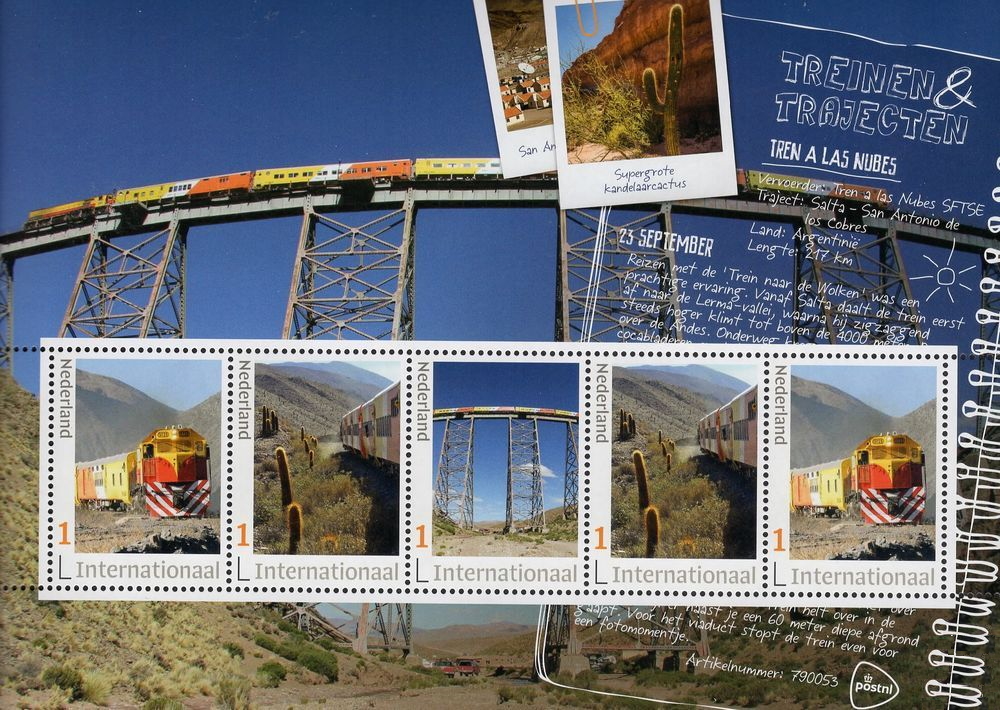
|
23rd September 2020: PostNL published a series of stamp sheets focusing on 25 unique train routes around the world, among others: Tren a las Nübes. The Tren a las Nübes (English: Train to the Clouds) is a tourist train service in Salta Province of Argentina. The service runs along the eastern part of the Salta-Antofagasta railway line of the Belgrano Railway (also known as the "C-14" line) that connects the Argentine Northwest with the Chilean border in the Andes mountain range, over 4,220 metres (13,850 ft) above mean sea level, the fifth highest railway in the world. Originally built for economic and social reasons, it is now primarily of interest to tourists as a heritage railway, though cheaper tickets are also available for locals to use the train as transport. The railway line has 29 bridges, 21 tunnels, 13 viaducts, 2 spirals and 2 zigzags. Because of the design decision not to use a rack-and-pinion for traction, the route had to be designed to avoid steep grades. The zigzags allow the train to climb up driving back and forth parallel to the slope of the mountain. It departs from Salta every Saturday at 07:05, and returns around midnight, though most tourists simply do the 8-hour one-way trip and return by other means. The train is composed of a dining carriage, bar carriage, a first aid area and two passenger carriages with room for 170 people, though this is expected to increase to 400 over time. Currently, the train leaves Salta station for the 15-hour, 434-kilometre (270 mile) round trip to the Polvorilla viaduct, located 4,220 m (13,850 ft) above sea level. [source: wikipedia] Catalogue of personalized stamps from The Netherlands: 3644-1-14 |
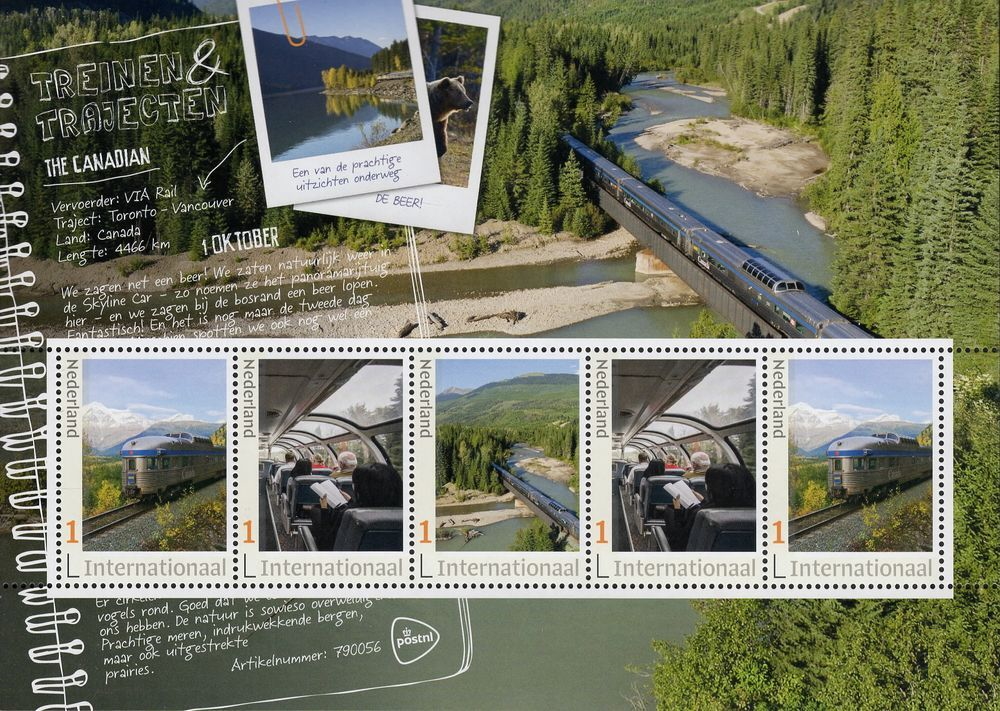
|
1st October 2020: PostNL published a series of stamp sheets focusing on 25 unique train routes around the world, among others: The Canadian. The Canadian (French: Le Canadien) is a transcontinental passenger train operated by Via Rail Canada with service between Union Station in Toronto, Ontario, and Pacific Central Station in Vancouver, British Columbia. Before 1955 the Canadian was a Canadian Pacific Railway (CPR) train between Toronto and Chicago. In 1955, CPR renamed its transcontinental route between Montreal/Toronto and Vancouver the Canadian, with new streamlined trains. Via Rail took over in 1978, and in 1990 reduced the Canadian to Toronto-Vancouver service primarily along Canadian National tracks. In 2014, the train served 93,810 passengers receiving a government subsidy of $591 per entrained passenger or $0.50 per passenger mile. Because the Canadian is used primarily by tourists, these subsidies have been the source of significant criticism. [source: wikipedia] Catalogue of personalized stamps from The Netherlands: 3644-1-17 |

|
17th November 2020: PostNL published a series of stamp sheets focusing on 25 unique train routes around the world, among others: The Venice Simplon-Orient Express. The Venice Simplon-Orient-Express (VSOE) is a private luxury train service from London to Venice and other European cities. It is currently owned by Belmond, which operates 45 luxury hotels, restaurants, tourist trains and river cruises in 24 countries. It was agreed in December 2018 for the service to be acquired by LVMH in a transaction initially expected to close in the first half of 2019. These VSOE services are not to be confused with a regularly scheduled train called the Orient Express, which ran nightly between Paris and Bucharest - in the last years of operation cut back to between Strasbourg and Vienna - until 11 December 2009. This latter service was a normal EuroNight sleeper train and was the lineal descendant of the regular Orient Express daily departure from Paris to Vienna and the Balkans. While this descendant train was primarily used for every sort of passengers to Central and Eastern Europe, applying only the standard international train fares, the VSOE train is aimed at tourists looking to take a luxury train ride. Fares on the Venice Simplon-Orient-Express are high as the service is intended not as an ordinary rail service, but as a leisure event with five-star dining included. The train was established in 1982 by James Sherwood of Kentucky, USA. In 1977 he had bought two original carriages at an auction when the Compagnie Internationale des Wagons-Lits withdrew from the Orient Express service, passing the service on to the national railways of France, Germany, and Austria. Over the next few years, Sherwood spent a total of US$16 million purchasing 35 sleeper, restaurant and Pullman carriages. On 25 May 1982, the first London-Venice run was made. The VSOE has separate restored carriages for use in the UK and for mainland Europe, but all of the same vintage (mostly dating from the 1920s and 1930s). Passengers are conveyed across the English Channel by coach on the Eurotunnel shuttle through the Channel Tunnel. In the UK Pullman carriages are used; in continental Europe sleeping cars and dining cars of the former Compagnie Internationale des Wagons-Lits are used. Sleeper carriages have a range of accommodation available including Grand Suites, Cabin Suites, Twin Cabins and Single cabins. [source: wikipedia] Catalogue of personalized stamps from The Netherlands: 3644-1-13 |

|
17th November 2020: PostNL published a series of stamp sheets focusing on 25 unique train routes around the world, among others: Eurostar. Eurostar is an international high-speed rail service connecting the United Kingdom with France, Belgium and the Netherlands. All Eurostar trains travel through the Channel Tunnel between the United Kingdom and France, which is owned and operated separately by Getlink. The London terminus is St Pancras International, the other British calling points are Ebbsfleet International and Ashford International in Kent. Intermediate calling points in France are Calais-Fréthun and Lille-Europe, with trains to Paris terminating at Gare du Nord. Trains to Belgium and the Netherlands serve Midi/Zuid station in Brussels, Rotterdam Centraal, before terminating at Amsterdam Centraal. Additionally, in France there are direct services from London to Disneyland Paris and seasonal direct services to southern France (Lyon, Avignon and Marseille) in summer, and to the French Alps in winter. The service is operated by eleven Class 373/1 trainsets with eighteen-coaches and seventeen Class 374 trainsets with sixteen-coaches which run at up to 320 kilometres per hour (199 mph) on high-speed lines. The LGV Nord high-speed line in France opened before Eurostar services began in 1994, and newer lines enabling faster journeys were added later - HSL 1 in Belgium and High Speed 1 in south-east England. The French and Belgian parts of the network are shared with Paris-Brussels Thalys services and TGV trains. Eurostar is operated by Eurostar International Limited (EIL), which is owned by the national railway of France, SNCF (55%), investment firms (40%), and the National Railway Company of Belgium (5%). [source: wikipedia] Catalogue of personalized stamps from The Netherlands: 3644-1-12 |
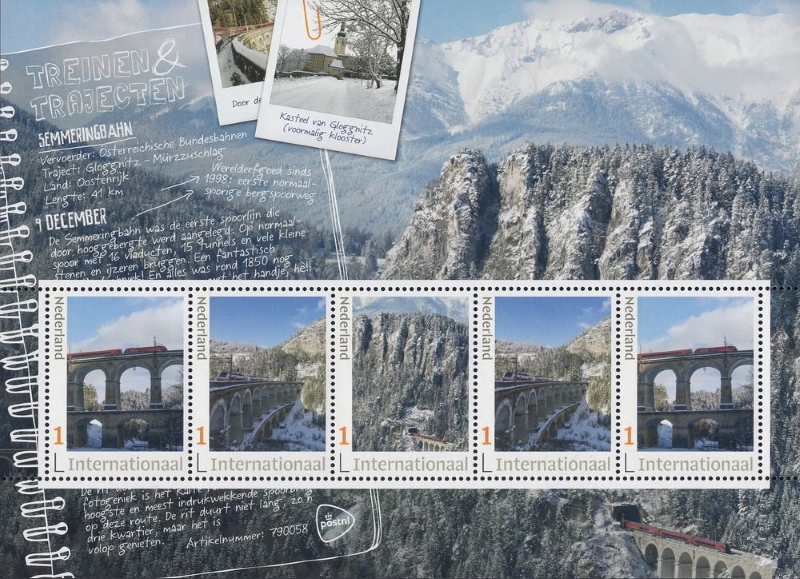
|
9th December 2020: PostNL published a series of stamp sheets focusing on 25 unique train routes around the world, among others: Semmeringbahn. The Semmering railway (German: Semmeringbahn) in Austria, which starts at Gloggnitz and leads over the Semmering to Mürzzuschlag, was the first mountain railway in Europe built with a standard gauge track. It is commonly referred to as the world's first true mountain railway, given the very difficult terrain and the considerable altitude difference that was mastered during its construction. It is still fully functional as a part of the Southern Railway which is operated by the Austrian Federal Railways. The Semmering railway was constructed between 1848 and 1854 by some 20,000 workers under the project's designer and director Carl von Ghega born in Venice as Carlo Ghega in an Albanian family. The construction features 14 tunnels (among them the 1,431 m summit tunnel), 16 viaducts (several two-storey) and over 100 stone arch bridges and 11 small iron bridges. The stations and the buildings for the supervisors were often built directly from the waste rock dug out when making the tunnels. Across an overall track length of 41 km the Semmering railway overcomes an altitude difference of 460 m; on 60% of its length the gradient is 2.0-2.5% (equivalent to a 1-meter difference in altitude on a 40 m route distance) and 16% exhibit a curvature radius of only 190 m. This was an entirely new technical dimension of railway construction, and new instruments and methods of surveying had to be developed to handle the resulting challenges. Also, new technologies were employed for the Engerth locomotives because the types in general use at this time could not handle the extreme gradients and turning radii. Even while being built, the Semmering railway was perceived as an effort of "landscape gardening", i.e. it attempted a harmonious combination of technology and nature. The unique travel experience which the Semmering railway offered contributed significantly to the original opening of the Semmering region for tourism. Numerous hotels and mansions are witnesses of this epoch. This enormous upswing to the turn of the century and the re-evaluation of the region as a winter sports area in the first third of the 20th Century were interrupted first by World War I and then by the changed recreational needs of the population. Therefore, this unique culture landscape could be preserved with little change. A trip on the Semmering railway, which is in full use 160 years after its building, still impresses the traveller as a special experience by its varied landscape, the typical style of its mansions and the characteristic sequence of viaducts and tunnels. In 1998 the Semmering railway was added to the list of the UNESCO World Heritage sites. [source: wikipedia] Catalogue of personalized stamps from The Netherlands: 3644-1-19 |
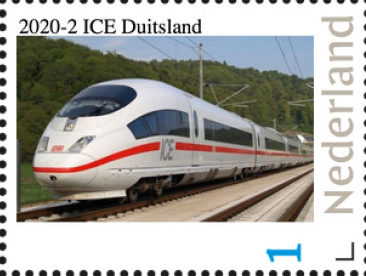 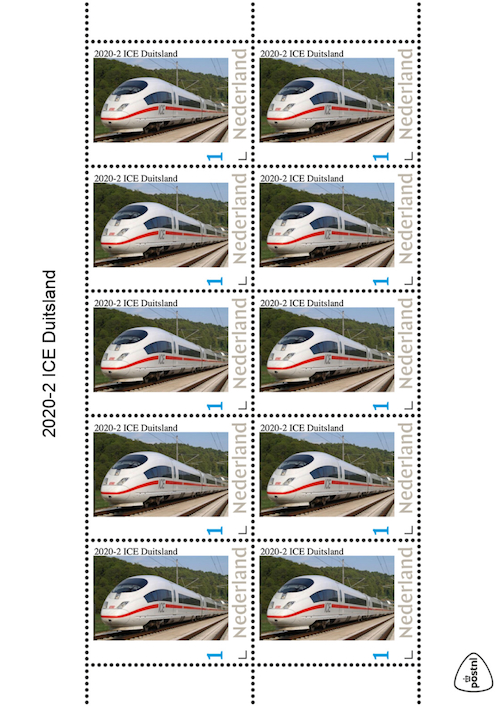 |
2020: Personalized stamp of a German ICE: Intercity Express (commonly known as ICE) is a high-speed rail system in Germany. It also serves destinations in Austria, France, Belgium, Switzerland and the Netherlands as part of cross-border services. It is the flagship of the German state railway, Deutsche Bahn. ICE fares are fixed for station-to-station connections, on the grounds that the trains have a higher level of comfort. Travelling at speeds up to 320 km/h (200 mph), they are aimed at business travellers and long-distance commuters and marketed by Deutsche Bahn as an alternative to flights. No entry in official catalogue |
 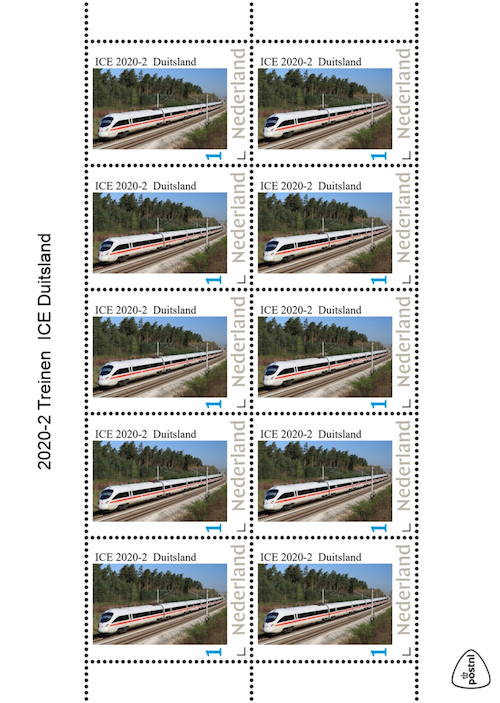 |
2020: Another personalized stamp of a German ICE: explanation above. No entry in official catalogue |
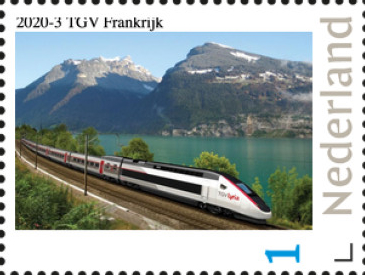  |
2020: Personalized stamp of a French TGV: The TGV (French: Train à Grande Vitesse (high-speed train); previously TurboTrain à Grande Vitesse) is France's intercity high-speed rail service, operated by SNCF. SNCF worked on a high-speed rail network from 1966 to 1974 and presented the project to President Georges Pompidou who approved it. Originally designed as turbotrains to be powered by gas turbines, TGV prototypes evolved into electric trains with the 1973 oil crisis. In 1976 the SNCF ordered 87 high-speed trains from Alstom. Following the inaugural service between Paris and Lyon in 1981 on the LGV Sud-Est (LGV for Ligne à Grande Vitesse; high-speed line), the network, centered on Paris, has expanded to connect major cities across France (including Marseille, Lille, Bordeaux, Strasbourg, Rennes and Montpellier) and in neighbouring countries on a combination of high-speed and conventional lines. The TGV network in France carries about 110 million passengers a year. No entry in official catalogue |
 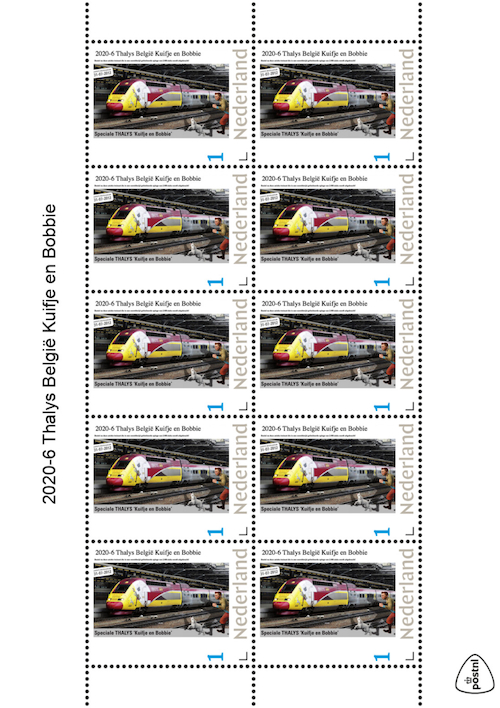 |
2020: Personalized stamp of a Belgian Thalys with Tintin on the side: Thalys is the commercial name of high-speed train services by the Eurostar Group since April 2022, and by Thalys International before that. These services connect Paris and Brussels, and extend to either Amsterdam or to German cities in the Rhein-Ruhr, including Aachen, Cologne, Düsseldorf, Duisburg, Essen and Dortmund. Since the merger of the two companies, these trains are labeled Eurostar Red as well. Thalys was created out of a political ambition formalised in October 1987 to establish a network of international high-speed railway services between the cities of Paris, Brussels, Cologne, and Amsterdam. The Thalys name was created in January 1995. The company procured a fleet of Alstom-built TGV trains to operate its services as they were viewed as the only existing rolling stock suitable to the task. No entry in official catalogue |
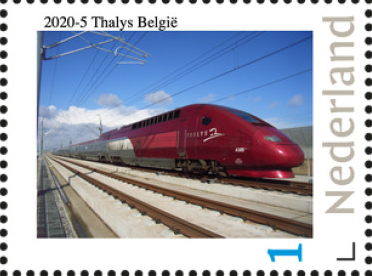  |
2020: Personalized stamp of a Belgian Thalys: See above. No entry in official catalogue |
 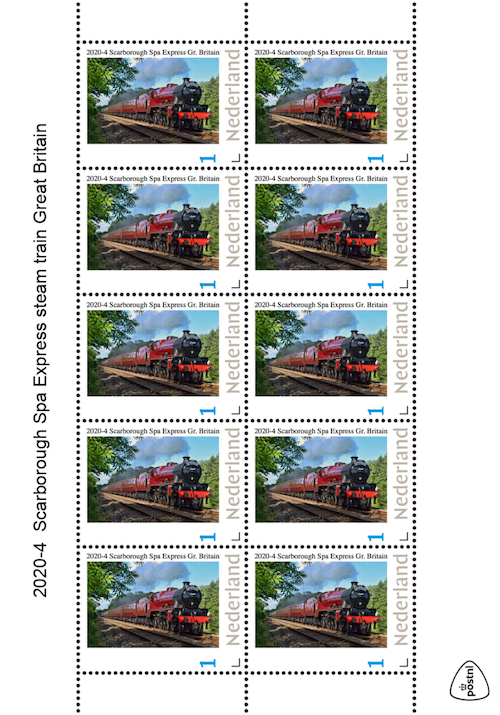 |
2020: Personalized stamp of Scarborough Spa Express The Scarborough Spa Express (SSE) is a regular summer heritage steam locomotive service between York and Scarborough. It is currently operated by the West Coast Railways, but has been operated in previous years by different companies, including the Railway Touring Company. Regular steam operations on most of British Rail (BR) ended in 1968. In the early 1970s, BR allowed steam back on the main line, using preserved steam locomotives, and in 1978 it ran a series of trains during the summer months on a circular route from York via Leeds and Harrogate. In 1981, the route was extended to Scarborough after a turntable was reinstated and named the Scarborough Spa Express. These ran until 1988, but ceased when the staff at York who were responsible were reassigned to separate divisions at InterCity and Regional Railways. The National Railway Museum (NRM) began running a service directly from York to Scarborough in 2004. 4472 Flying Scotsman, having just been acquired by the NRM, was the main locomotive used, but 45407 The Lancashire Fusilier was available in the event of any failure.[2] 5972 Olton Hall also stood in on at least one occasion, still wearing its Hogwarts Expres livery. The NRM sponsored the SSE until the end of 2006, when they decided to hand over the running of the SSE to the Railway Touring Company. In 2007, the Railway Touring Company included the Harrogate loop in the SSE itinerary once more and ran a number of very successful tours during July and August. In 2008-2009, WCR took over the running of the SSE and they again utilised the Harrogate loop, running on three days a week during July and August. In 2010, the route was changed when gauging problems on the Harrogate loop put a stop to any steam locomotive using that route. This is how the Wakefield Circle was born, with WCR again running the SSE three days a week during July and August. The route was York-Normanton-Wakefield Kirkgate-Wakefield Westgate-Woodlesford-Castleford and back to York; then, from York the usual trip to Scarborough and back to York and the Wakefield Circle as per the morning run, and finally returning to York at 21-00. It was intended that the same route would be used in 2012. As in 2019, it operates on selected Thursdays during the summer, being hauled by a WCR diesel from Carnforth to York where a steam locomotive takes over for the journey to Scarborough. No entry in official catalogue |

|
December 2020: Christmas stamp (reduced price) with a Swiss Rhätische Bahn train. No entry in official catalogue |
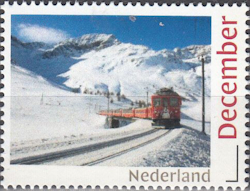
|
unknown year: Christmas stamp (reduced price) with a Swiss Bernina Express train. No entry in official catalogue |
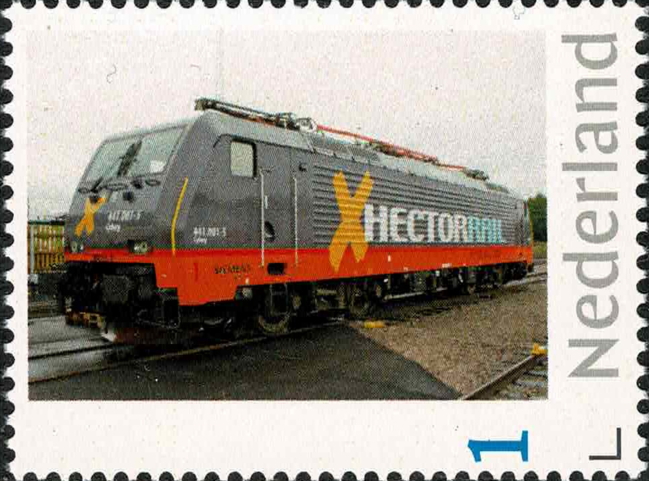
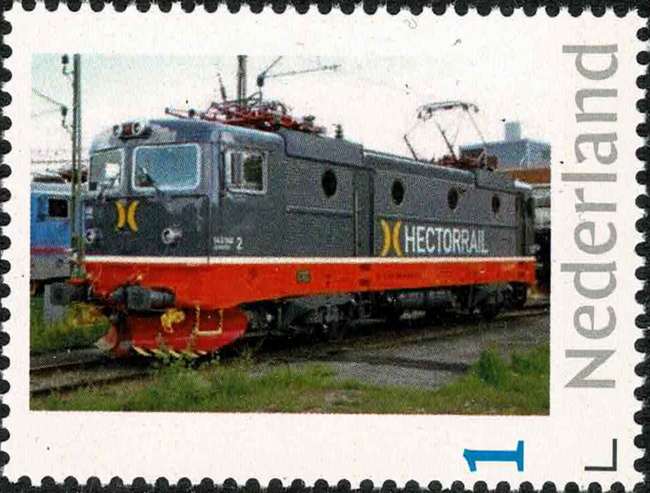 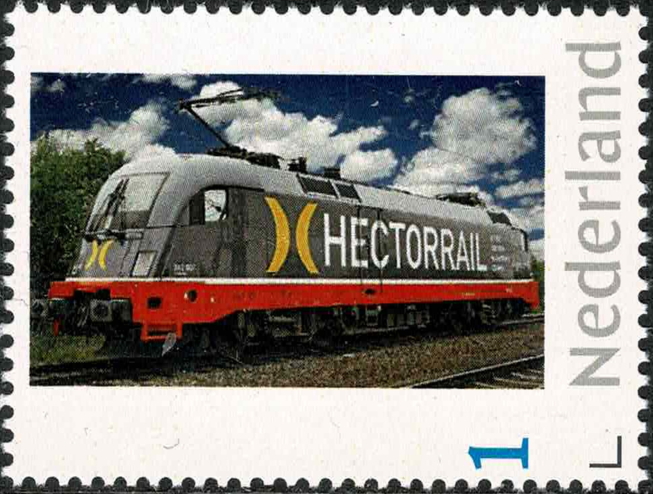
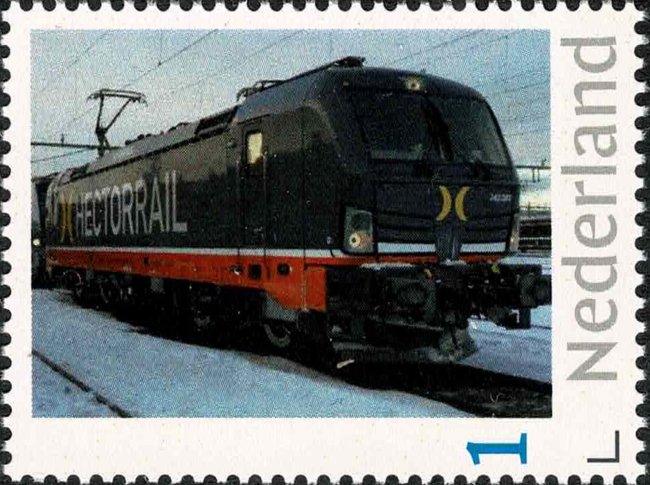 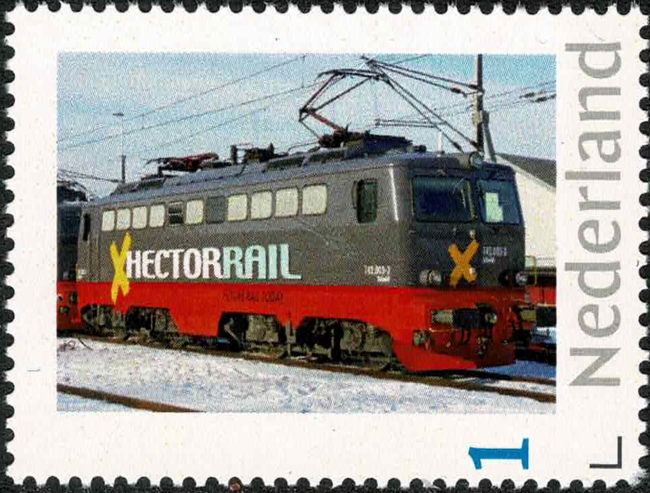
|
unknown year: A set of five personalised stamps with Hector Rail locomotives Hector Rail is a Swedish-based independent train haulage provider operating in the European rail transport market, operating 50 locomotives. The company provides locomotives and drivers to freight customers who need to have whole unit trains hauled between two places with a regular timetable. Hector Rail ran its first train on 12 December 2004, and now operates around 5 million train-km a year in Sweden and Norway. It began operating in Denmark and running trains from Sweden to Germany during January 2008. In 2009 Hector rail started to haul a passenger train, for Veolia. During 2016 Hector Rail took ownership of GB Railfreight after GBRF was purchased by EQT Partners. No entry in official catalogue |
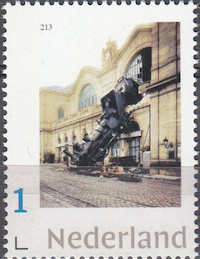
|
unknown year: The Montparnasse derailment occurred at 16:00 on 22 October 1895 when the Granville-Paris Express overran the buffer stop at its Gare Montparnasse terminus. With the train several minutes late and the driver trying to make up for lost time, it approached the station too fast and the driver's application of the train air brake was ineffective. After running through the buffer stop, the train crossed the station concourse and crashed through the station wall; the locomotive fell onto the Place de Rennes below, where it stood on its nose. Although the passengers survived, a woman in the street below was killed by falling masonry. On 22 October 1895, the Granville to Paris and Montparnasse express, operated by Chemins de fer de l'Ouest, was made up of steam locomotive No. 721 (a type 2-4-0, French notation 120) hauling three luggage vans, a post van, and six passenger coaches. The train had left Granville on time at 08:45, but was several minutes late as it approached its Paris Montparnasse terminus with 131 passengers on board. In an effort to make up lost time, the train approached the station faster than usual, at a speed of 40-60 km/h (25-37 mph), and when the driver attempted to apply the Westinghouse air brake, it was faulty or ineffective. The locomotive brakes alone were insufficient to stop the train, the momentum carried it into the buffers, and the locomotive crossed the almost 30-metre (98 ft) wide station concourse, crashing through a 60-centimetre (24 in) thick wall, before falling onto the Place de Rennes 10 metres (33 ft) below, where it stood on its nose. No entry in official catalogue |
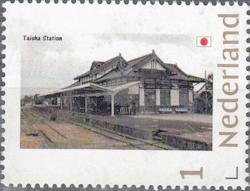
|
unknown year: The Japanese town of Taisha was formerly connected to Izumo by a JR West line, however the station and line from Izumo to Taisha was closed in 1990. Taisha old JR station remains as a historic building and museum. No entry in official catalogue |
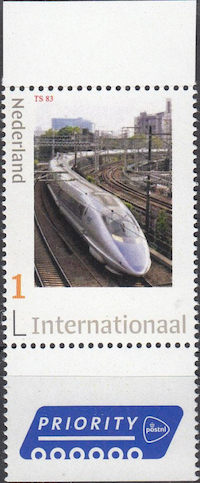
|
unknown year: Starting with the Tokaido Shinkansen (515.4 km; 320.3 mi) in 1964, the Shinkansen network has expanded to currently consist of 2,830.6 km (1,758.9 mi) of lines with maximum speeds of 240–320 km/h (150-200 mph), 283.5 km (176.2 mi) of Mini-Shinkansen lines with a maximum speed of 130 km/h (80 mph), and 10.3 km (6.4 mi) of spur lines with Shinkansen services. The network presently links most major cities on the islands of Honshu and Kyushu, and Hakodate on northern island of Hokkaido, with an extension to Sapporo under construction and scheduled to commence in March 2031. The maximum operating speed is 320 km/h (200 mph) (on a 387.5 km (241 mi) section of the Töhoku Shinkansen). Test runs have reached 443 km/h (275 mph) for conventional rail in 1996, and up to a world record 603 km/h (375 mph) for SCMaglev trains in April 2015. No entry in official catalogue |
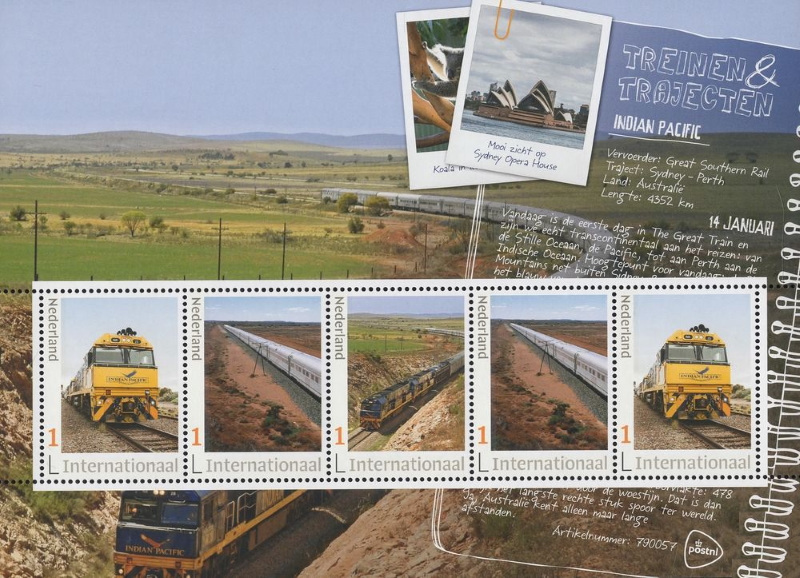
|
14th January 2021: PostNL published a series of stamp sheets focusing on 25 unique train routes around the world, among others: Indian Pacific. The Indian Pacific is an Australian tourist passenger train that operates between Sydney, on the Pacific Ocean coast, and Perth, on the Indian Ocean coast. It is one of the few truly transcontinental trains in the world (the other in Australia being The Ghan, which operates from the north to the south of the Australian continent). It first ran in February 1970 after the completion of gauge conversion projects in South Australia and Western Australia, enabling for the first time a cross-continental rail journey that did not have a break of gauge. The train's route includes the world's longest straight stretch of railway track, a 478-kilometre (297 mile) stretch of the Trans-Australian Railway across the Nullarbor Plain. The service was originally operated jointly by four government railway administrations: the Department of Railways New South Wales, South Australian Railways, Commonwealth Railways and Western Australian Government Railways, until February 1993 when Australian National took full ownership. In October 1997, the Indian Pacific was sold to Great Southern Rail now known as Journey Beyond Rail Expeditions. The Indian Pacific is considered to be one of the great rail journeys of the world. A one-way trip takes between 70.5 and 75 hours, depending on scheduling and daylight saving periods. The train currently has two classes, branded as Platinum and Gold Service. A motorail service conveys passengers' motor vehicles between Adelaide and Perth. [source: wikipedia] Catalogue of personalized stamps from The Netherlands: 3644-1-18 |

|
30th March, 2021: PostNL published a series of stamp sheets focusing on 25 unique train routes around the world, among others: Panama Railroad or Panama Canal Railway. The Panama Canal Railway (Spanish: Ferrocarril de Panamá) is a railway line linking the Atlantic Ocean to the Pacific Ocean in Central America. The route stretches 47.6 miles (76.6 km) across the Isthmus of Panama from Colón (Atlantic) to Balboa (Pacific, near Panama City). Because of the difficult physical conditions of the route and state of technology, the construction was renowned as an international engineering achievement, one that cost US$8 million and the lives of an estimated 5,000 to 10,000 workers. Opened in 1855, the railway preceded the Panama Canal by half a century; the ship canal was later constructed parallel to the railway. Known as the Panama Railroad Company when founded in the 19th century, today it is operated as Panama Canal Railway Company (reporting mark: PCRC). Since 1998 it has been jointly owned by Kansas City Southern and Mi-Jack Products and leased to the government of Panama. The Panama Canal Railway currently provides both freight and passenger service. The line was built by the United States and the principal incentive was the vast increase in passenger and freight traffic from eastern USA to California following the 1849 California Gold Rush. The United States Congress had provided subsidies to companies to operate mail and passenger steamships on the coasts, and supported some funds for construction of the railroad, which began in 1850; the first revenue train ran over the full length on January 28, 1855. Referred to as an inter-oceanic railroad when it opened, it was later also described by some as representing a "transcontinental" railroad, despite transversing only the narrow isthmus connecting the North and South American continents. For a time the Panama Railroad also owned and operated ocean-going ships that provided mail and passenger service to a few major US East Coast and West Coast cities, respectively. The infrastructure of this railroad was of vital importance to the construction of the Panama Canal over a parallel route half a century later. [source: wikipedia] Catalogue of personalized stamps from The Netherlands: 3644-1-20 |

|
27th April, 2021: PostNL published a series of stamp sheets focusing on 25 unique train routes around the world, among others: Himalaya Express. The Himalaya Express runs from Beijing to Lhasa. The trains are specially built for high elevation environments. The passenger carriages used on Lhasa trains are specially built and have an oxygen supply for each passenger. Every passenger train has a doctor. Launched in July 2006, the Beijing to Lhasa train (No.Z21), stretching as far as 3,757 km, has been one of the three initial railway routes to Tibet. Crossing eight provinces from Northern China Plain to the world highest Qinghai-Tibet Plateau, the train journey is a long railway adventure taking more than 40 hours from Beijing to Lhasa. Departing from the capital city in northeast China, the train will first pass through the vast flatland with countryside scenery, as it heads to the central inland cities. After Lanzhou, the train will move towards Xining, the starting point of the breathtaking Qinghai-Tibet Railway, which extends as long as 1,110 km until Lhasa. The highlight of the train ride lies in the section from Xining to Lhasa. The train will traverse some of the most breathtaking landscapes along the way, such as Qarhan Salt Lake, Gobi Desert, snow-capped Yuzhu Peak, lofty Tanggula Mountain, and massive grassland etc., leaving a valuable train experience for tourists taking the Tibet train. The train from Beijing to Lhasa leaves at 20:00 at night and arrives in Xining at 14:57 on the second day. From Xining, it begins to run along the scenic Qinghai-Tibet Railway, mainly passing the Qinghai Lake and Chaidamu Basin during the day time. Then on the third day of the ride, after crossing the Tanggula Mountains at night, you will have half of the day to enjoy scenery of Tibet plateau, before the train arrives in Lhasa at 12:40. Inversely, if you take the train from Lhasa to Beijing, you will first go through the night stay onboard before the train arrives in Golmud in the next morning. Thus, there may be less chance for you to see window scenery via the return journey. [source: wikipedia] Catalogue of personalized stamps from The Netherlands: 3644-1-16 |
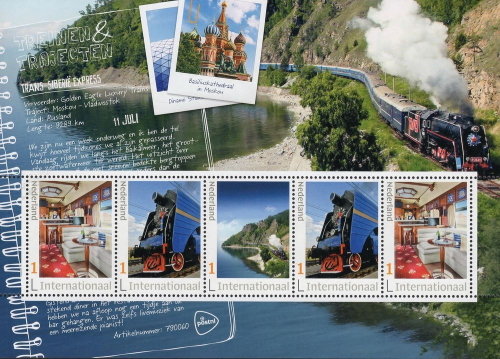
|
11th July, 2021: PostNL published a series of stamp sheets focusing on 25 unique train routes around the world, among others: Trans-Siberian Railway. The Trans-Siberian Railway is a network of railways connecting Western Russia to the Russian Far East. It is the longest railway line in the world, with a length of over 9,289 kilometres (5,772 miles), starting from the capital Moscow, the largest city in Europe, and ending at Vladivostok, on the Pacific Ocean. Russian Empire government ministers personally appointed by the Emperor Alexander III of Russia and by his son, the Tsarevich Nicholas (later Emperor Nicholas II from 1894), supervised the building of the railway between 1891 and 1916. Even before its completion, the line attracted travellers who wrote of their adventures. The Trans-Siberian Railway has directly connected Moscow with Vladivostok since 1916. Expansion of the railway system continues as of 2021, with connecting rails going into Asia, namely Mongolia, China and North Korea. There are also plans to connect Tokyo, the capital of Japan, to the railway via bridges between the mainland and the islands of Sakhalin and Hokkaido. The main route of the Trans-Siberian Railway begins in Moscow at Yaroslavsky Vokzal, runs through Yaroslavl or Chelyabinsk, Omsk, Novosibirsk, Krasnoyarsk, Irkutsk, Ulan-Ude, Chita, and Khabarovsk to Vladivostok via southern Siberia. A second primary route is the Trans-Manchurian, which coincides with the Trans-Siberian east of Chita as far as Tarskaya (a stop 12 km (7 mi) east of Karymskoye, in Chita Oblast), about 1,000 km (621 mi) east of Lake Baikal. From Tarskaya the Trans-Manchurian heads southeast, via Harbin and Mudanjiang in China's Northeastern Provinces (from where a connection to Beijing is used by one of the Moscow-Beijing trains), joining with the main route in Ussuriysk just north of Vladivostok. This is the shortest and the oldest railway route to Vladivostok. While there are currently no traverse passenger services (enter China from one side and then exit China and return to Russia on the other side) on this branch, it is still used by several international passenger services between Russia and China. [source: wikipedia] Catalogue of personalized stamps from The Netherlands: 3644-1-21 |
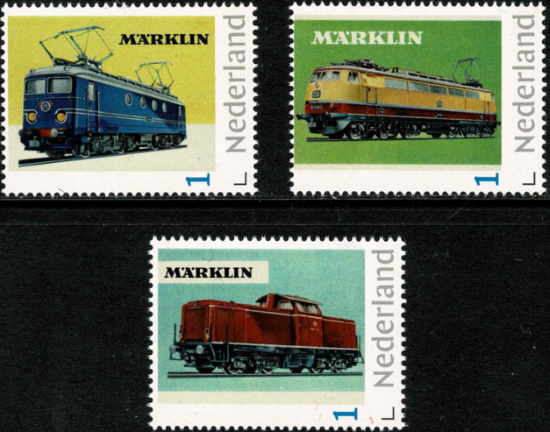
|
2021: Personalized stamps with Märklin model locomotive picture postcards from the 1950s. Catalogue of personalized stamps from The Netherlands: ?? |
  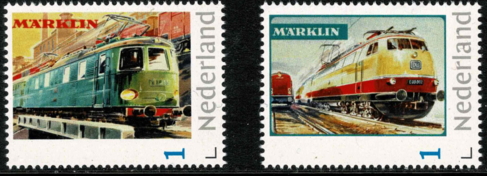 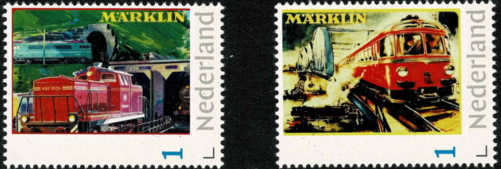 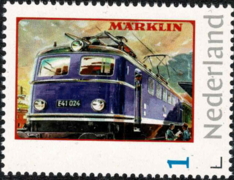
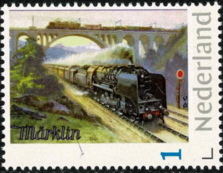
|
2021: Personalized stamps with Märklin model railway catalogue covers. Catalogue of personalized stamps from The Netherlands: ?? |
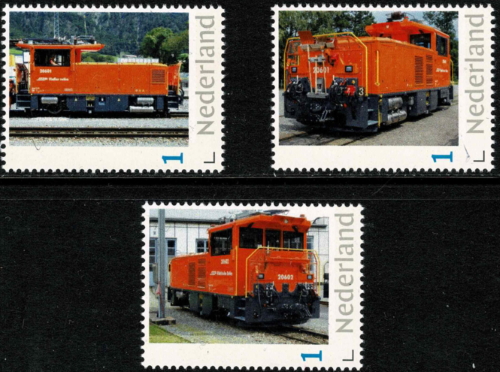

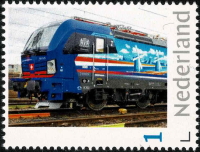
|
2021: Several Swiss locomotives: Top: three Rhätische Bahn shunting locomotives, Series Geaf 2/2. Then a Series Ee 922 Stadler shunting locomotive and an SBB Cargo Vectron "Rotterdam". Catalogue of personalized stamps from The Netherlands: ?? |


|
2021: United States of America: USA Alaska Rail loco and an Americab railroad crossing. Catalogue of personalized stamps from The Netherlands: ?? |

|
22nd September 2021: South Africa: Bloutrein or Blue Train The Blue Train travels an approximately 1,600-kilometre (990 mi) journey in South Africa between Pretoria and Cape Town. It is one of the most luxurious train journeys in the world. It boasts butler service, two lounge cars (smoking and non-smoking), an observation car, and carriages with gold-tinted picture windows, in soundproofed, fully carpeted compartments, each featuring its own en-suite (many of which are equipped with a full-sized bathtub). The service is promoted as a "magnificent moving five-star hotel" by its operators, who note that kings and presidents have travelled on it. The Blue Train's origins date back to 1923, when the Union Express commenced between Johannesburg and Cape Town, it was named the Union Limited in the reverse direction. The Union Express introduced luxury features such as a dining saloon in 1933 and air-conditioned carriages from Metro-Cammell in 1939. After being withdrawn in 1942 due to World War II, the service returned in 1946. With the reintroduction of the train, the colloquial "blue train" moniker, a reference to the blue-painted steel carriages introduced in 1937, was formally adopted as the new name. In 1955 it began to be hauled by 3E electric locomotives between Cape Town and Touws River. In 1959 a Wegmann & Co built air-conditioned dining and kitchen car was inserted into each set. In September 1972, two 16 carriage sets built by Union Carriage & Wagon were introduced. In 1997 it was refurbished and relaunched. In 2015, Class 20Es 20-031 and 20-032 were assigned to the train replacing Class 18Es. [source: wikipedia] Catalogue of personalized stamps from The Netherlands: 3644-1-22 |
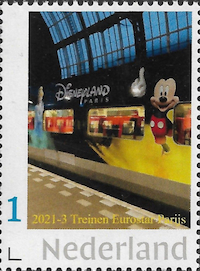 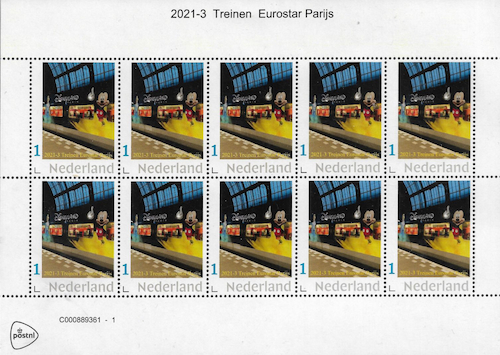 |
2021: Personalized stamp of Eurodisney: Every Friday, Saturday, Sunday and Monday a direct Thalys train departs from Amsterdam, Schiphol, Rotterdam and Antwerp to Marne-la-Vallée/Chessy (Disneyland Paris). For the return journey, a direct Thalys train also departs every Friday, Saturday, Sunday and Monday from Marne-la-Vallée/Chessy (Disneyland Paris) to Antwerp, Rotterdam, Schiphol and Amsterdam. Book your train trip to Disneyland Paris with Thalys or with NS International (from any station in the Netherlands). The exact days on which the direct Thalys operates may vary per week. No entry in official catalogue |
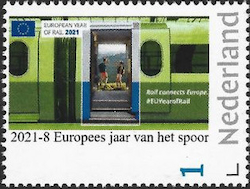
|
2021: Personalized stamp for The European Year of Rail 2021: The year 2021 has been declared the European Year of rail with the main goal of boosting rail as a sustainable, innovative, interconnected and intermodal, safe and affordable mode of transport in line with the objectives set out in the European Green Deal and the Sustainable and Smart Mobility Strategy. No entry in official catalogue |
   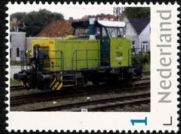 |
2022: several foreign countries: This set of 10 personalized stamps was for sale at Philamaxx in a limited edition of 10 sets. Catalogue of personalized stamps from The Netherlands: ?? |
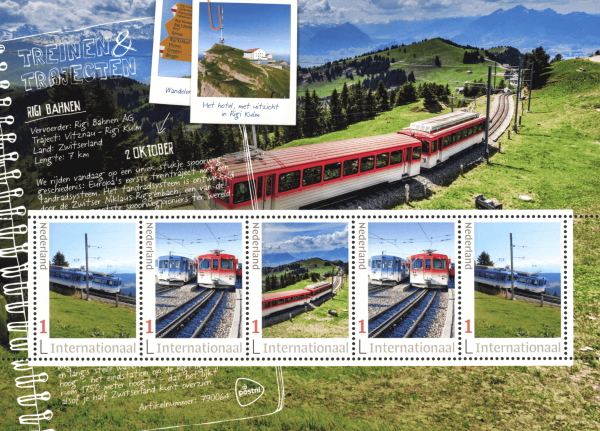 |
21-04-2022: PostNL published a series of stamp sheets focusing on 25 unique train routes around the world, among others: Rigi Bahnen: Rigi Railways (German: Rigi Bahnen) is a railway company that operates a group of railways on the mountain Rigi, located between two of the arms of Lake Lucerne, in Switzerland. They include two standard gauge rack railways, the Vitznau-Rigi Bahn (VRB) and the Arth-Rigi Bahn (ARB), along with the Luftseilbahn Weggis-Rigi Kaltbad (LWRK) cable car. Reaching a height of 1,752 metres (5,748 ft) above sea level, the Rigi Railways are the highest standard gauge railway in Europe. They are also the highest railway in both cantons of Lucerne and Schwyz. The Vitznau-Rigi Bahn is also notable as the first mountain rack railway in Europe, and even the second in the world, after the Mount Washington Cog Railway in the United States. The construction of the railway began in September 1869. The limited liability company, which had offered 1250 shares was greatly over-subscribed on the first day of issue. On 21 May 1870, Niklaus Riggenbach Riggenbach's birthday [inventor of the Riggenbach rack system and the counter-pressure brake], locomotive No.1, named Stadt Luzern, made its first trial run. Exactly one year later the first mountain railway using rack and pinion technology was officially opened. The line, from Vitznau to Rigi Staffelhöhe was 5 km (3.1 mi) long and climbed a total of 1,115 m (3,658 ft) to reach a height of 1,550 m (5,085 ft) at its summit, the maximum gradient being 1 in 4 (25%). The first electrification, on the short section of line from Arth to Goldau, came with the commencement of the winter timetable in 1906. In 1931 the Rigi-Scheidegg Railway, which had never been electrified, was closed. It was not until 1 January 1959, when the section of the Arth-Rigi line between Arth, on Lake Zug, and Arth-Goldau station was replaced by a bus service, that the second closure took place. The Arth-Rigi line then terminated in its station above the main line tracks. A new rail connection was built at Rigi Staffel, linking the Arth-Rigi Railway and the Vitznau-Rigi Railway, and opened in 1990. In 1992 the two railway companies merged to become the Rigi Railways Company and in the same year took over the Rigi Ski Lift Company. [source: wikipedia] Catalogue of personalized stamps from The Netherlands: 3644-1-25 |
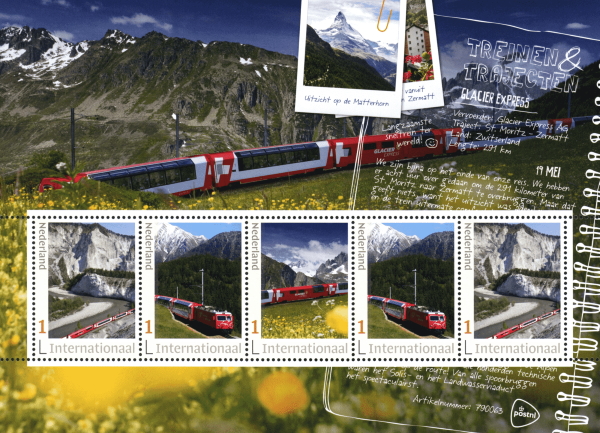 |
21-04-2022: PostNL published a series of stamp sheets focusing on 25 unique train routes around the world, among others: Glacier Express: The Glacier Express (GEX) is a direct train connecting railway stations of the two major mountain resorts of Zermatt and St. Moritz via Andermatt in the central Swiss Alps. The train is not an "express" in the sense of being a high-speed train, but rather, in the sense that it provides a one-seat ride for an 8-hours-long end-to-end 291 km (181 mi) journey, and omits stops made by local trains. The Glacier Express is known as the slowest express train in the world. As St. Moritz and Zermatt are home to two well-known mountains, the Glacier Express is also said to travel from Matterhorn to Piz Bernina. The journey from Zermatt starts at the dead end of an Alpine valley, the Mattertal, just below the world-renowned Matterhorn at an elevation of 1,606 m (5,269 ft) before it descends to the huge valley of the Valais in Brig. It traverses the 291-kilometre-long (181 mi) journey through the center of the Swiss Alps, over 291 bridges, through 91 tunnels, such as the 15.4 km-long (9.6 mi) Furka Tunnel at an elevation of 1,500 m (4,900 ft) to circumvent the Furka Pass, makes an intermediate stop at Andermatt on a secluded high Alpine valley, just to traverse its highest point on the Oberalp Pass at 2,033 m (6,670 ft) in order to descend to its lowest point at Chur at 585 m (1,919 ft). From Chur, the capital of the canton of Graubünden, the GEX backtracks to higher altitudes again in order to reach the resort St. Moritz in a further valley to the south. Previously, before traversing the Albula Range by a tunnel at 1,800 metres (5,900 ft), in Filisur travelers can change to a connecting train to reach Davos to the east. Since 2017 the train is operated by the Glacier Express AG, a cooperation jointly owned by the former operators Matterhorn Gotthard Bahn (MGB) and Rhaetian Railway (RhB). For much of its journey, it also passes along and through the World Heritage Site known as the Rhaetian Railway in the Albula / Bernina Landscapes. The first Glacier Express started on 30 June 1930 07:30 in Zermatt. Initially, it was operated by three railway companies: the Visp-Zermatt-Bahn (VZ), the Furka Oberalp Bahn (FO), and the RhB. Since 2003, the train has been operated by RhB and the MGB, which arose from a merger between the BVZ and the FO. Since 2017 the Glacier Express AG, owned by the two former operators, runs the train of the same name. The entire line is metre gauge (narrow gauge railway), with 23.9 kilometres (14.9 mi) using the rack-and-pinion system both for ascending steep grades and to control descent. [source: wikipedia] Catalogue of personalized stamps from The Netherlands: 3644-1-24 |

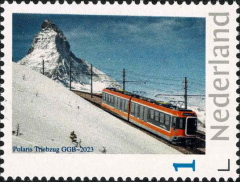 |
2022: Left: personalized stamp by Philamaxx commemorating 175 years of Swiss Railways. Right: personalized stamp by Philamaxx with Polaris Triebfahrzueg. This is the latest addition to the Swiss Gornergratbahn, at a test run. It will be commissioned in 2023. Catalogue of personalized stamps from The Netherlands: ?? |
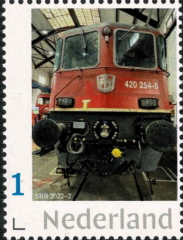
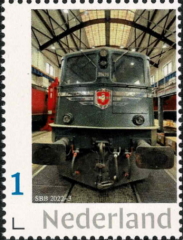 
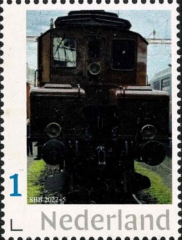 
 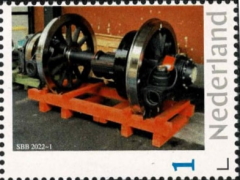
 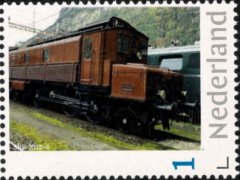
 
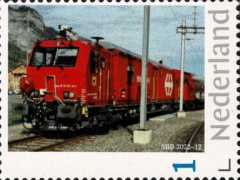 
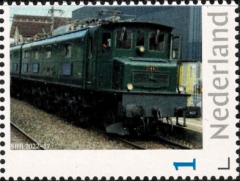 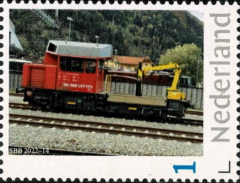
 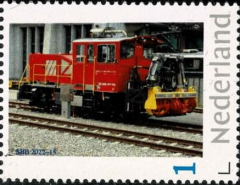
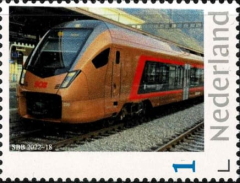 |
2022: Philamaxx personalized stamps with photographs taken during the SBB Open Days on 22 and 23 October 2022. Catalogue of personalized stamps from The Netherlands: ?? |
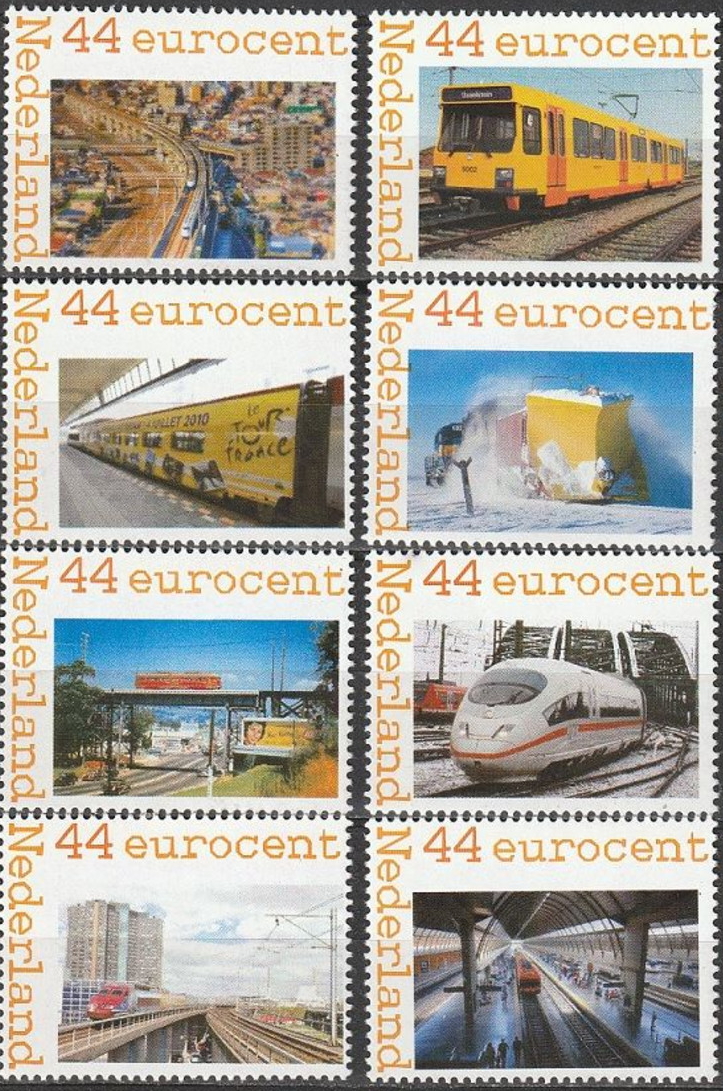 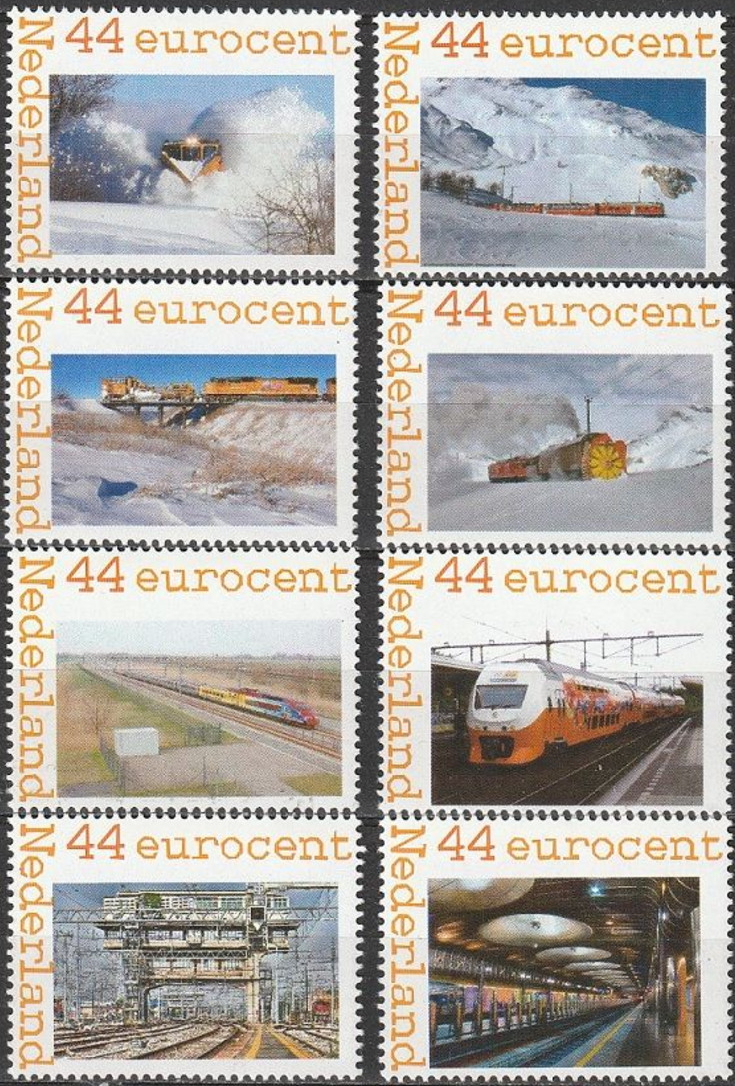 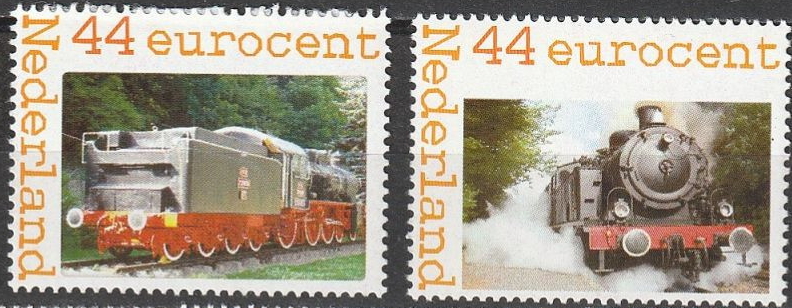 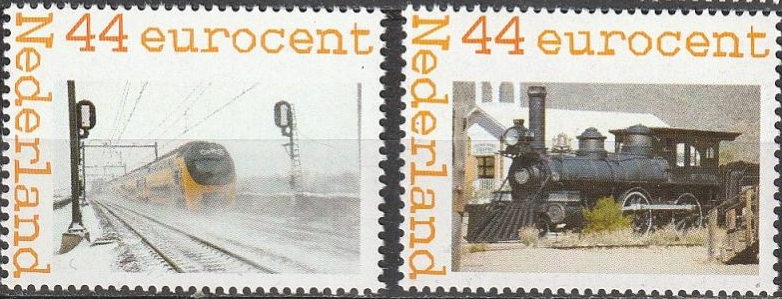 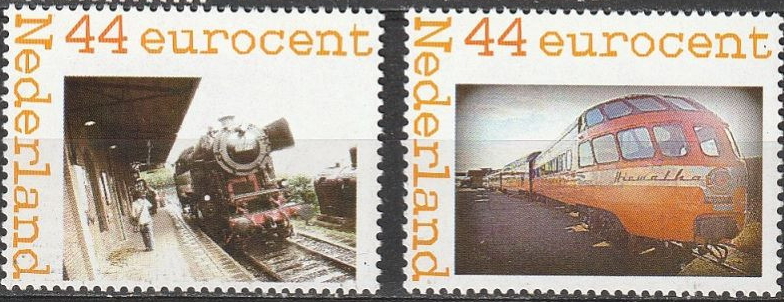 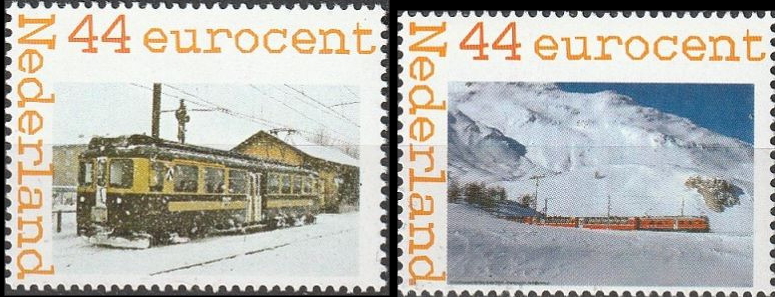 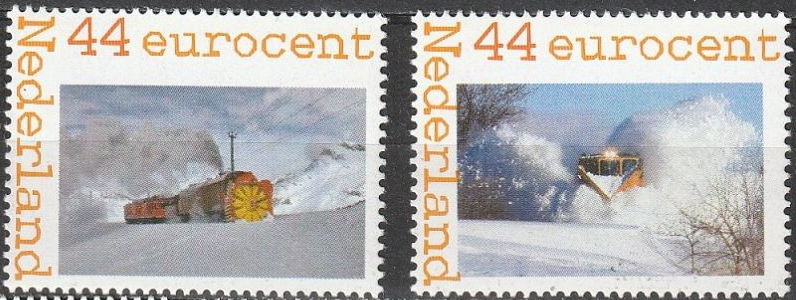 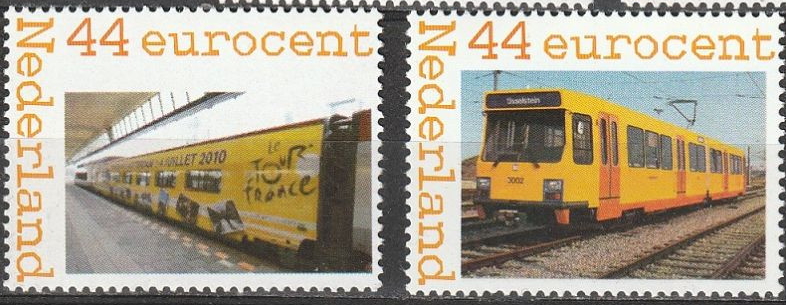 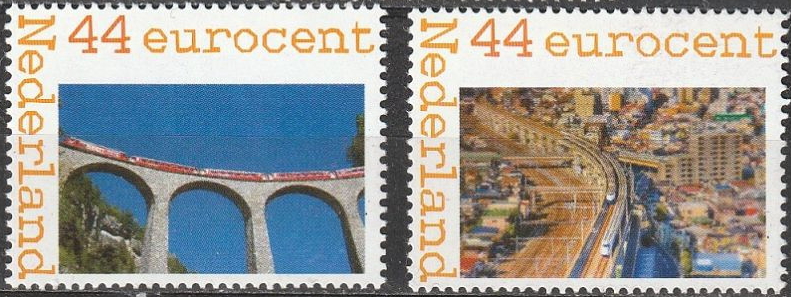 |
year ??: Set of personalized December stamps with several foreign trains, metros and stations. Catalogue of personalized stamps from The Netherlands: ?? |
 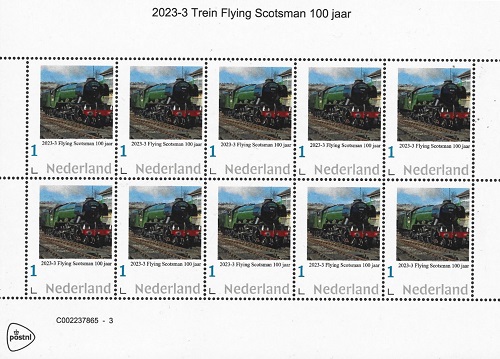
|
2023: The Flying Scotsman is an express passenger train service that operates between Edinburgh and London, the capitals respectively of Scotland and England, via the East Coast Main Line. The service began in 1862 as the Special Scotch Express until it was officially adopted in 1924. It is currently operated by the London North Eastern Railway. The East Coast Main Line over which the Flying Scotsman service runs was built in the 19th century by many small railway companies, but mergers and acquisitions led to only three companies controlling the route; the North British Railway (NBR), the North Eastern Railway (NER) and the Great Northern Railway (GNR). In 1860 the three companies established the East Coast Joint Stock for through services using common vehicles, and it is from this agreement that the Flying Scotsman came about. The first Special Scotch Express ran in 1862, with simultaneous departures at 10:00 from the GNR's London King's Cross and the NBR's Edinburgh Waverley. The original journey took ten and a half hours, including a half-hour stop at York for lunch. Increasing competition and improvements in railway technology saw this time reduced to eight and a half hours by the time of the Race to the North in 1888. From 1896, the train was modernised, introducing such features as corridors between carriages, heating, and dining cars. As passengers could now take luncheon on the train, the York stop was reduced to 15 minutes, but the end-to-end journey time remained eight and a half hours. Like the earlier carriages built for the service, this rolling stock was jointly owned by the three operating companies, and formed part of the pool known as the East Coast Joint Stock. Under British Rail, the Flying Scotsman ceased to be a non-stop train, calling at Newcastle, York and Peterborough. It also operated at times beyond Edinburgh. On 1 June 1981, the northbound journey was extended to Aberdeen. The Flying Scotsman name has been maintained by the operators of the InterCity East Coast franchise since the privatisation of British Rail; the former Great North Eastern Railway even subtitled itself The Route of the Flying Scotsman. The Flying Scotsman was operated by GNER from April 1996 until November 2007, then by National Express East Coast until November 2009, East Coast until April 2015, and Virgin Trains East Coast until June 2018. Since then it has been operated by the government-owned London North Eastern Railway. [source: Wikipedia] Catalogue of personalized stamps from The Netherlands: ?? |
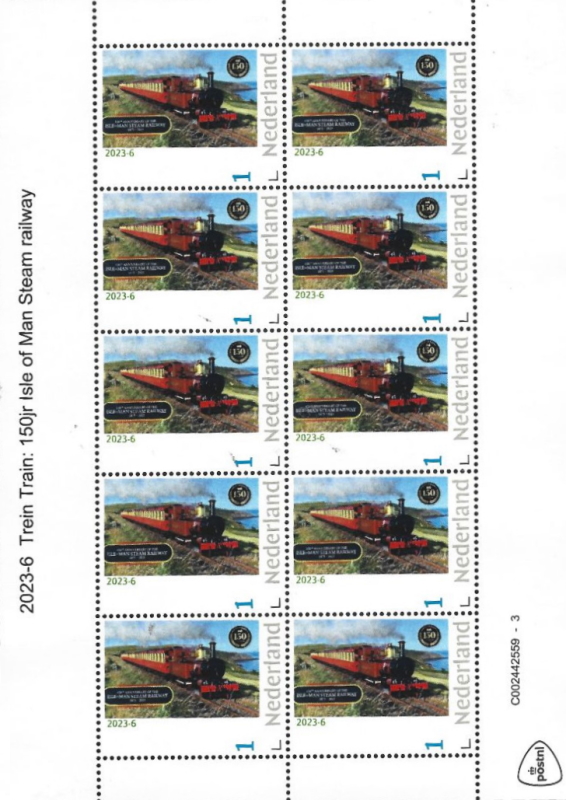
|
2023: 150th anniversary of the Isle of Man Steam Railway. The Isle of Man Railway (IMR) (Manx: Raad Yiarn Vannin) is a narrow gauge steam-operated railway connecting Douglas with Castletown and Port Erin on the Isle of Man. The line is 3 ft (914 mm) narrow gauge and 15 and a half miles (25 kilometres) long. It is the remainder of what was a much larger network (over 46 miles or 74 kilometres) that also served the western town of Peel, the northern town of Ramsey and the small mining village of Foxdale. Now in government ownership, it uses original rolling stock and locomotives and there are few concessions to modernity. Its first line, from Douglas to Peel, opened on 1 July 1873, followed by the Port Erin line on 1 August 1874. Initially the Port Erin line had been planned to terminate at Castletown, but the construction of deep water docks at Port Erin caused an extension to the line. A few years after completion, the dock was destroyed by heavy seas and the idea of deep water vessels abandoned there. The remains of the breakwater are still visible at low tide. A third line was built in 1878-1879 by the Manx Northern Railway, from St John's (on the Douglas to Peel line) to Ramsey. A further short line was constructed from St John's to Foxdale in 1885 to serve the lead mines there. Although it was built by the nominally independent Foxdale Railway, it was leased to and operated by the Manx Northern. The loss of the mineral traffic from Foxdale and competition for the Douglas-Ramsey passenger traffic from the Manx Electric Railway placed the Manx Northern Railway in financial difficulties. It was taken over by the IMR in 1904. During the mid-1920s the IMR formed a bus subsidiary that operated most of the island's bus services, and helped the railway to remain profitable into the 1960s. The first serious examination of the long term viability of the railway came with the Howden Report in 1949, which recommended the closure of the Ramsey line, which was already losing money; the eventual closure of the Peel line, which was breaking even in the late 1940s; and the retention of the then profitable Port Erin line. Howden also reported that the existing equipment of the railway had an economic life of 10-25 years. Economies were made throughout the 1950s and early 1960s. These included the ending of evening and Sunday services, the deferral of track maintenance, and cuts to train mileage as locomotives became unserviceable. To further reduce expenses, there were winter closures of the Peel line (1960-61 only) and the Ramsey line after September 1961, but A. M. Sheard, the then general manager, refused to close the Ramsey line which by this time was losing a considerable amount of money each year. Following the closure of the County Donegal Railways in 1960, the IMR purchased the CDR's two most modern diesel railcars, which were then largely used on the Peel line in summer, and after 1962 worked the whole of the winter service except when withdrawn for maintenance. The system closed after the 1965 season but was briefly revived when the Marquess of Ailsa obtained a lease and reopened all three routes in 1967. Both the Peel and Ramsey lines shut following the 1968 season, but goods services between Peel and Milntown (just short of Ramsey) continued until mid-1969. Traffic was poor on the two northern lines, especially that to Ramsey, so after the end of the 1968 season, Ailsa decided to concentrate on passenger service on the South Line for three more seasons until he took the option to end his lease at the close of the 1971 season. There were occasional empty coaching stock workings between Douglas and St John's in 1970 and 1971 for the retrieval of stored stock between seasons. During this time most of the early wooden framed carriages were moved to St John's, where they were lost in a fire in July 1975. The Peel and Ramsey routes and the Foxdale line were lifted in 1975. The IMR operated services between Douglas and Port Erin after Lord Ailsa took his five-year option, beginning in 1972 through the centenaries of the Peel and Port Erin lines in 1973 and 1974 respectively. In 1975, the Port Erin line operated only from its southwestern terminus to Castletown, but it was found that half a railway made twice the loss. The government sponsored a short extension of the service from Castletown to Ballasalla in 1976, and, after extensive campaigning during the 1976 Tynwald elections, the railway returned to Douglas in 1977, the last year in which the railway was operated by the IMR. Following nationalisation the railway has continued to be operated seasonally, for many years from Easter weekend until the end of September, more recently from around 1 March to early November. [source: Wikipedia] Catalogue of personalized stamps from The Netherlands: ?? |
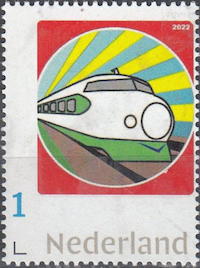
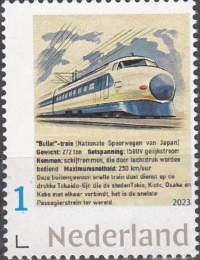
|
2022 and 2023: Japanese bullet train. The one on the left is from 2022 and the one on the right is from 2023. The Shinkansen or Bullet Train is a network of high-speed railway lines in Japan. Initially, it was built to connect distant Japanese regions with Tokyo, the capital, to aid economic growth and development. Beyond long-distance travel, some sections around the largest metropolitan areas are used as a commuter rail network. It is owned by the Japan Railway Construction, Transport and Technology Agency and operated by five Japan Railways Group companies. Over the Shinkansen's 50-plus-year history, carrying over 10 billion passengers, there has not been a single passenger fatality or injury on board due to derailments or collisions. Starting with the Tokaido Shinkansen (515.4 km; 320.3 mi) in 1964, the network has expanded to currently consist of 2,830.6 km (1,758.9 mi) of lines with maximum speeds of 240–320 km/h (150–200 mph), 283.5 km (176.2 mi) of Mini-Shinkansen lines with a maximum speed of 130 km/h (80 mph), and 10.3 km (6.4 mi) of spur lines with Shinkansen services. The original Tokaido Shinkansen, connecting Tokyo, Nagoya and Osaka, three of Japan's largest cities, is one of the world's busiest high-speed rail lines. In the one-year period preceding March 2017, it carried 159 million passengers, and since its opening more than five decades ago, it has transported more than 6.4 billion total passengers. [source: Wikipedia] Catalogue of personalized stamps from The Netherlands: ?? |
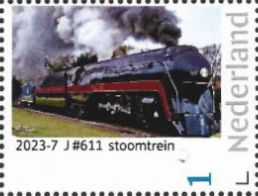 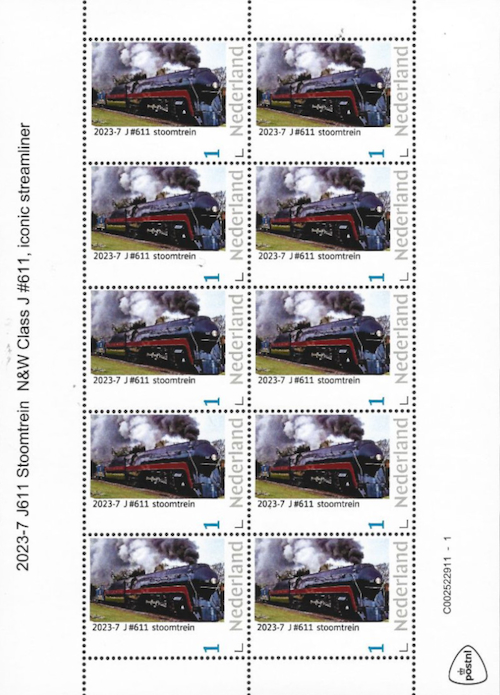 |
2023: Streamliner steam locomotive of the N & W Class J, number 611. Norfolk & Western 4-8-4 (Class J) was one of the most powerful locomotive classes ever built. These machines not only carried an elegant, beautiful streamlining but were also very fast, capable of speeds approaching 100 mph! The N&W were master steam builders, arguably better than the commercial manufacturers, and outshopped more than a dozen 4-8-4's over a decade's period. The J's handled all of the railroad's top trains, notably the Powhatan Arrow and Pocahontas, but also occasionally found themselves in freight assignments. [source: american-rails.com] Catalogue of personalized stamps from The Netherlands: ?? |
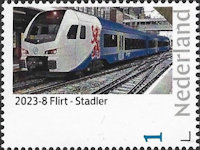 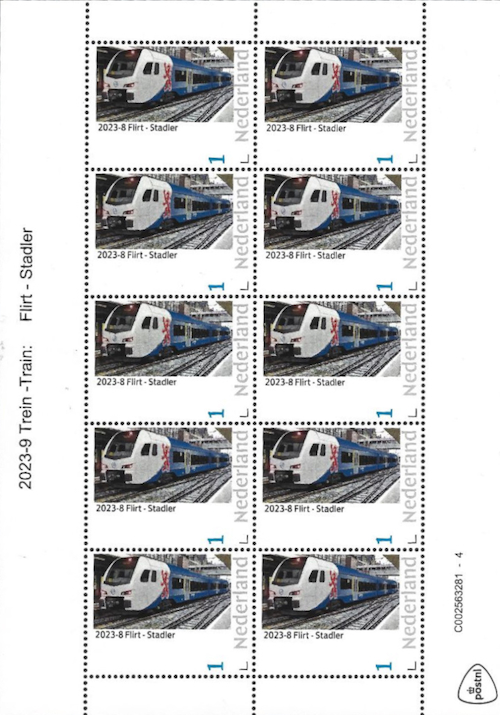 |
2023: Stadler FLIRT (Fast Light Intercity and Regional Train) is a passenger multiple unit trainset made by Stadler Rail of Switzerland. The baseline design of FLIRT is an electric multiple unit articulated trainset that can come in units of two to twelve cars with two to six motorized axles. The maximum speed is 200 km/h (124 mph). The FLIRT train was originally developed for the Swiss Federal Railways and was first delivered in 2004. Aside from being electric (EMU), the FLIRT is available in a diesel-electric version (DEMU), and recently also as an electro-diesel multiple unit first ordered by the Aosta Valley region in Italy (BTR.813). [source: Wikipedia] Catalogue of personalized stamps from The Netherlands: ?? |
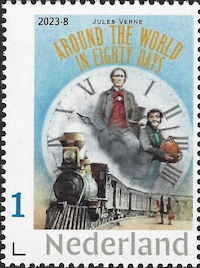 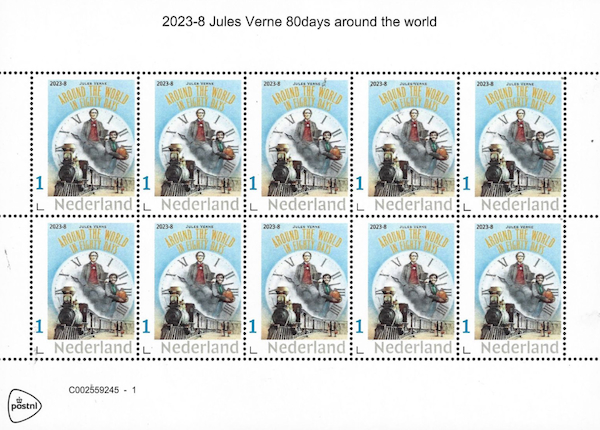 |
2023: Around the World in Eighty Days (French: Le tour du monde en quatre-vingts jours) is an adventure novel by the French writer Jules Verne, first published in French in 1872. In the story, Phileas Fogg of London and his newly employed French valet Passepartout attempt to circumnavigate the world in 80 days on a wager of £20,000 (equivalent to £1.9 million in 2019) set by his friends at the Reform Club. It is one of Verne's most acclaimed works. The part that is situated in the United states of America, comprises a rail trip from San Francisco to New York City. In San Francisco, they board a transcontinental train to New York, encountering several obstacles along the way: a massive herd of bison crossing the tracks, a failing suspension bridge and a band of Sioux warriors ambushing the train. After uncoupling the locomotive from the carriages, Passepartout is kidnapped by the Indian warriors. Fogg rescues him after American soldiers volunteer to help. They continue by a wind-powered sledge to Omaha, where they get a train to New York. [source: Wikipedia] Catalogue of personalized stamps from The Netherlands: ?? |
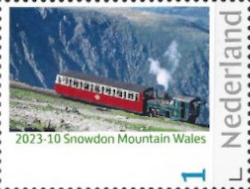 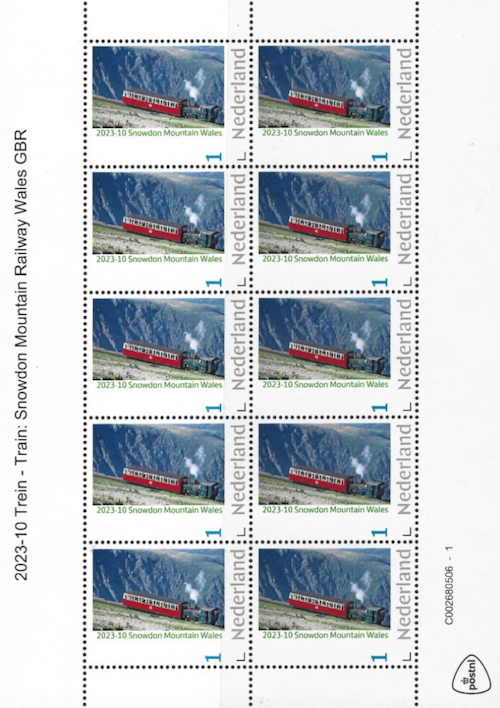
|
2023: The Snowdon Mountain Railway is a narrow gauge rack and pinion mountain railway in Gwynedd, north-west Wales. It is a tourist railway that travels for 4.7 miles (7.6 km) from Llanberis to the summit of Snowdon, the highest peak in Wales. The SMR is the only public rack and pinion railway in the United Kingdom, and after more than 100 years of operation it remains a popular tourist attraction, carrying more than 140,000 passengers annually. The line is owned and operated by Heritage Great Britain, operators of several other tourist attractions in the United Kingdom. The railway is operated in some of the harshest weather conditions in Britain, with services curtailed from reaching the summit in bad weather and remaining closed during the winter from November to mid-March. Single carriage trains are pushed up the mountain by either steam locomotives or diesel locomotives. It has also previously used diesel railcars as multiple units. [source: Wikipedia] Catalogue of personalized stamps from The Netherlands: ?? |
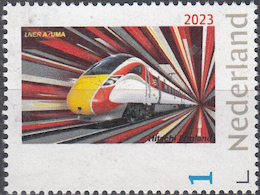
|
2023: British Rail Class 800, branded by Great Western Railway (GWR) as Intercity Express Train (IET), and by London North Eastern Railway (LNER) as Azuma, is a type of bi-mode multiple unit train built by Hitachi Rail for GWR and LNER. The type uses electric motors powered from overhead electric wires for traction, but also has diesel generators to enable trains to operate on unelectrified track. It is a part of the Hitachi AT300 product family. [source: Wikipedia] Catalogue of personalized stamps from The Netherlands: ?? |
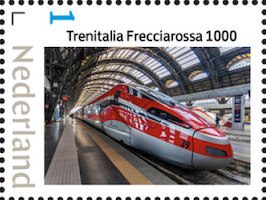 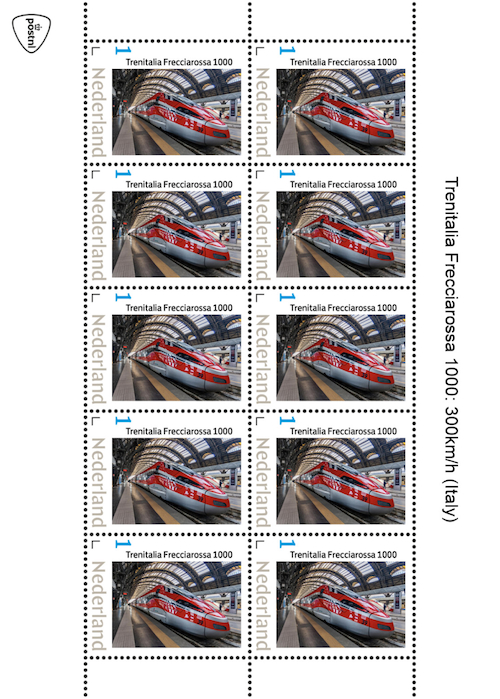
|
2023: Frecciarossa is a high-speed train of the Italian national train operator, Trenitalia, as well as a member of the train category Le Frecce. The name, which, if spelled Freccia rossa means Red arrow in English, was introduced in 2008, after it had previously been known as Eurostar Italia. Frecciarossa trains operate at speeds of up to 300 km/h (190 mph). [source: Wikipedia] Catalogue of personalized stamps from The Netherlands: ?? |
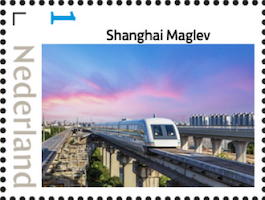 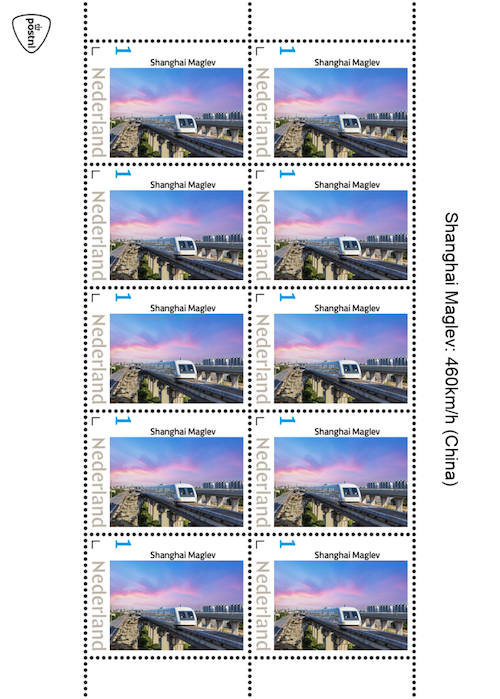
|
2023: The Shanghai maglev train (SMT) or Shanghai Transrapid is a magnetic levitation train (maglev) line that operates in Shanghai, China. The line uses the German Transrapid technology. The Shanghai maglev is the world's first commercial high-speed maglev and has a maximum cruising speed of 300 km/h (186 mph). Prior to May 2021 the cruising speed was 431 km/h (268 mph), at the time this made it the fastest train service in commercial operation. [source: Wikipedia] Catalogue of personalized stamps from The Netherlands: ?? |
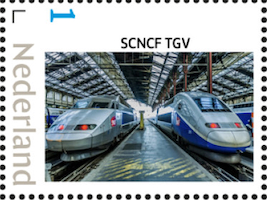 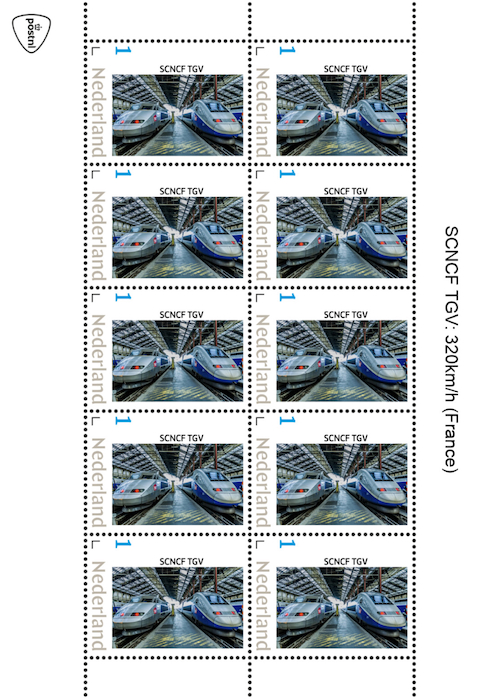
|
2023: The TGV Atlantique (TGV-A) is a class of high-speed trains used in France by SNCF; they were built by Alstom between 1988 and 1992, and were the second generation of TGV trains, following on from the TGV Sud-Est trainsets. The trains were named after the Ligne à Grande Vitesse Atlantique (Atlantic high-speed line) that they were originally built for. [source: Wikipedia] Catalogue of personalized stamps from The Netherlands: ?? |
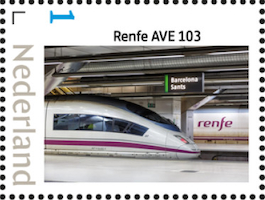 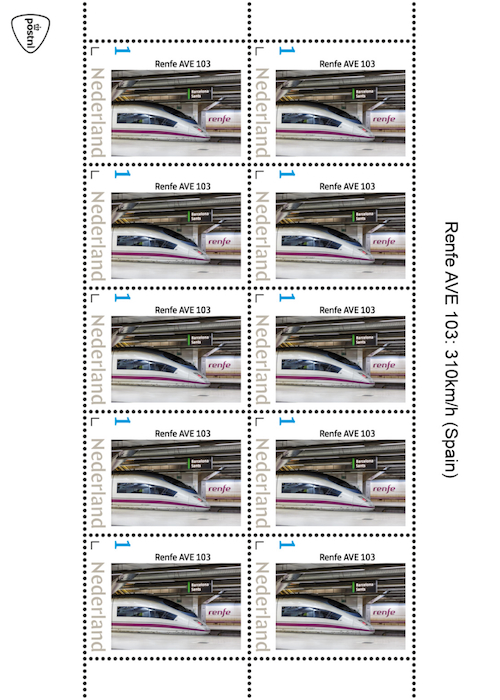
|
2023: Alta Velocidad Española (AVE)[a] is a high-speed rail service operated by Renfe, the Spanish State railway company. The first AVE service was inaugurated in 1992, with the introduction of the first Spanish high-speed railway connecting the cities of Madrid, Córdoba and Seville. In addition to Renfe's use of the ADIF-managed rail infrastructure in Spain, Renfe offers two AVE services partially in France, connecting respectively Barcelona-Lyon and Madrid-Marseille. [source: Wikipedia] Catalogue of personalized stamps from The Netherlands: ?? |
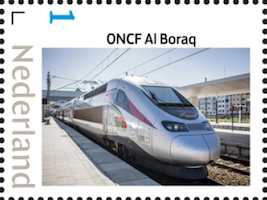 
|
2023: Al Boraq is a 323-kilometre (201 mi) high-speed rail service between Casablanca and Tangier in Morocco. The first of its kind on the African continent, it opened on 15 November 2018 after a decade of planning and construction by ONCF, Morocco's national railway company. On the 186 km (116 mi) section from Tangier to Kenitra, trains run on a dedicated high-speed line and travels up to 320 km/h (199 mph). For the final 137 km (85 mi), trains run on an upgraded mainline from Kenitra through Rabat and Morocco's most populous corridor to Casablanca. [source: Wikipedia] Catalogue of personalized stamps from The Netherlands: ?? |
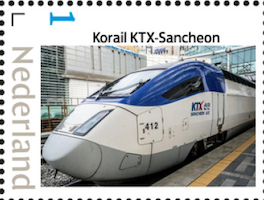 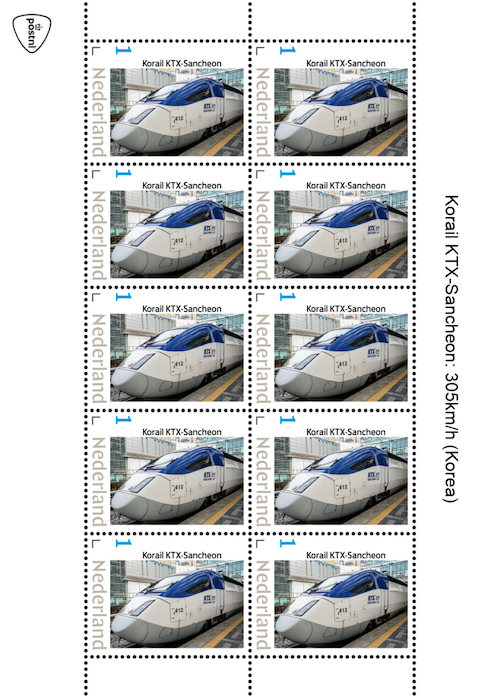
|
2023: The KTX-Sancheon (formerly called the KTX-II) is a South Korean high-speed train built by Hyundai Rotem in the second half of the 2000s and operated by Korail since March 2010. With a top speed of 305 km/h (189.5 mph), the KTX-Sancheon is the second commercial high-speed train operated in South Korea and the first domestic high-speed train that is designed and developed in South Korea. [source: Wikipedia] Catalogue of personalized stamps from The Netherlands: ?? |
 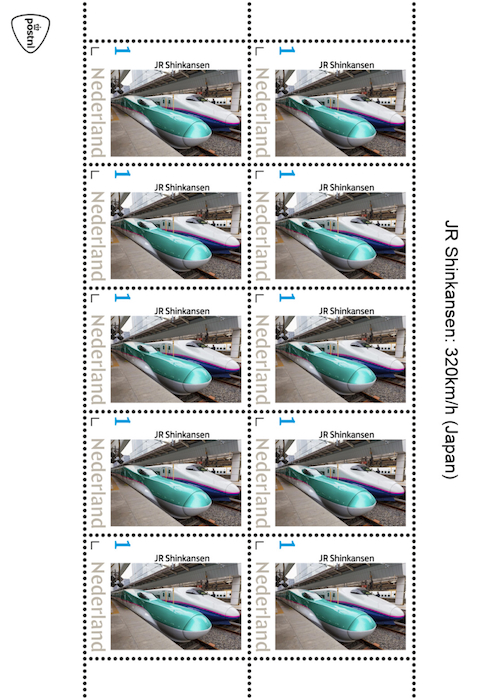
|
2023: The E2 series Shinkansen at the back and in the foreground the E5 series Shinkansen. The E2 series is a Japanese high-speed Shinkansen train type operated by East Japan Railway Company (JR East) on the Tohoku Shinkansen high-speed lines in Japan since 1997. They are formed in 8- and 10-car sets. The 8-car sets were used on the Hokuriku Shinkansen, and the 10-car sets are on Tohoku Shinkansen services. The 10-car sets can be coupled to E3 series sets using couplers hidden behind retracting nose doors. They operate at a maximum speed of 275 km/h (171 mph) on the Tohoku Shinkansen. The E5 series and the related H5 series are Japanese Shinkansen high-speed train types built by Hitachi Rail and Kawasaki Heavy Industries. The E5 series is operated by East Japan Railway Company (JR East); it was introduced on Tohoku Shinkansen services on 5 March 2011 and on Hokkaido Shinkansen services on 26 March 2016. A total of 59 10-car sets are on order, with three sets in service in time for the start of new Hayabusa services to Shin-Aomori in March 2011. [source: Wikipedia] Catalogue of personalized stamps from The Netherlands: ?? |
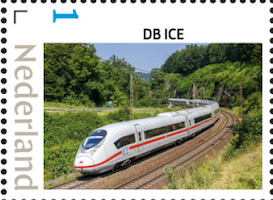 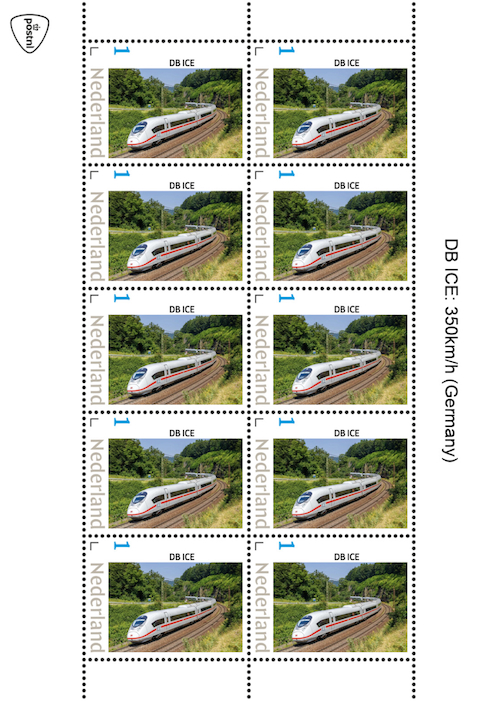
|
2023: ICE 3, or Intercity-Express 3, is a family of high-speed electric multiple unit trains operated by Deutsche Bahn. It includes classes 403, 406, 407 and 408, which are known as ICE 3, ICE 3M, New ICE 3 and ICE 3neo respectively. Based on the ICE 3M/F, Siemens developed its Siemens Velaro train family with versions used in Germany, Belgium, France, the United Kingdom, the Netherlands, Spain, China, Russia and Turkey. ICE 3 trains have a maximum speed of 320 km/h (200 mph) when travelling on the high-speed rail lines, however class 403 are permitted to go up to a maximum speed of 330 km/h (210 mph) when it travels on the high-speed route between Frankfurt and Cologne. [source: Wikipedia] Catalogue of personalized stamps from The Netherlands: ?? |
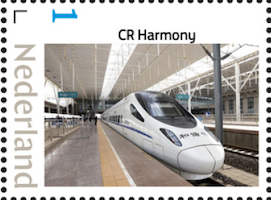 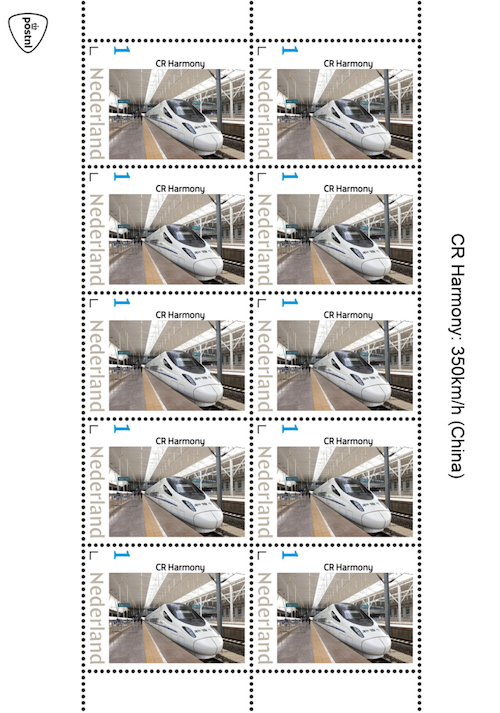
|
2023: Hexie (lit. Harmony), also known as the CRH series EMU, is an umbrella term for the multiple unit high-speed and higher-speed trains operated by China Railway under the China Railway High-speed brand. All series of Hexie are based on foreign-developed technology and later manufactured locally in China through technology transfer licenses, with the ultimate goal of China acquiring the know-how and capability to produce high-speed rail trains. The Harmony series does not belong to any single platform, instead encompassing all high-speed trains in China with roots in foreign technology, specifically CRH1, CRH2, CRH3 and CRH5. Although later variants of Hexie such as CRH380A were designed by Chinese companies, they are still classified as CRH due to incorporation of foreign technology. [source: Wikipedia] Catalogue of personalized stamps from The Netherlands: ?? |
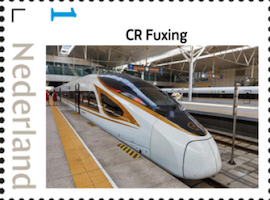 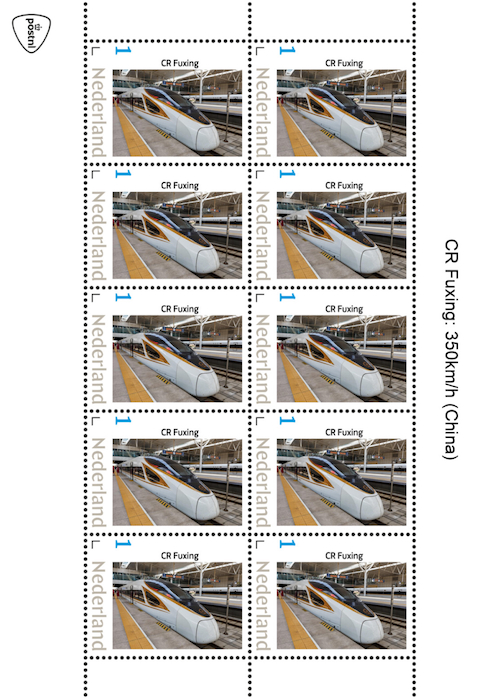
|
2023: Fuxing (lit. Rejuvenation), also known as the CR series EMU, or as the Fuxing Hao, is a series of high-speed and higher-speed EMU trains operated by China Railway High-speed (CRH) and developed by CRRC, which owns the independent intellectual property rights entirely. The Fuxing series do not contain any technology that is patented or licensed by foreign train makers, and demonstrates China's ability to build faster trains through homegrown innovations. [source: Wikipedia] Catalogue of personalized stamps from The Netherlands: ?? |
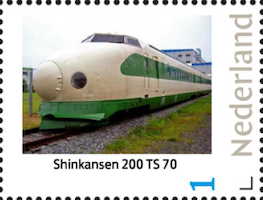 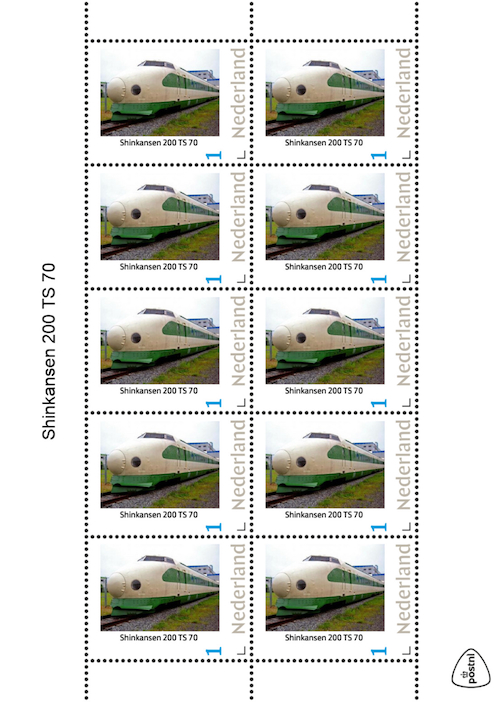
|
2023: Shinkansen 200 TS 70 (TS stands for Tohoku Shinkansen and 70 for the seating capacity) The 200 series was a Shinkansen high-speed train type introduced by Japanese National Railways (JNR) for the Tohoku Shinkansen and Joetsu Shinkansen high-speed rail lines in Japan, and operated by East Japan Railway Company (JR East) until 2013. They were originally painted in ivory with a green window band and lower bodyside band, but a number of sets were refurbished and painted into a white-upper/dark blue-lower scheme with new wrap-around cab windows from 1999. The first units were capable of 210 km/h (130 mph) but later ones can do 240 km/h (149 mph), and four were converted to be capable of 275 km/h (171 mph). Some units were also modified with retractable couplers in the nose for coupling with Yamagata Shinkansen Tsubasa and Akita Shinkansen Komachi Mini-shinkansen sets. In addition, some of the later 200 series Shinkansen trains were fitted with double-deck cars, which had semi-open standard-class compartments on the lower deck and green class (first class) seating on the upper deck. These too have been removed from service. Withdrawal of the earlier units began in 1997, and the last remaining unrefurbished set was withdrawn in May 2007. [source: Wikipedia] Catalogue of personalized stamps from The Netherlands: ?? |